Archive
Documentation of exhibitions, events and other cultural activities hosted and/or organised by David Pestorius at a diverse venues and locations since the early 1990s exists in a variety of forms, including announcements, posters, magazine advertisements, gallery guide listings, large and small format transparencies, catalogues, monographs, press releases, gallery fly-sheets, lists of works, set lists, newspaper and magazine reviews and articles, master video-tape recordings, DVDs, CDs, digital files, correspondence, etc. This archive material is stored and may be inspected at the Pestorius Sweeney House. The following is an edited sampling of photo-documentation, Media Releases, commissioned essays, and other information relating to projects undertaken since 2009 as well as selected earlier projects. Photography by Paul Bai, Sam Cranstoun, David Pestorius, Viki Petherbridge, Richard Stringer, Carl Warner, and Mark Webb.
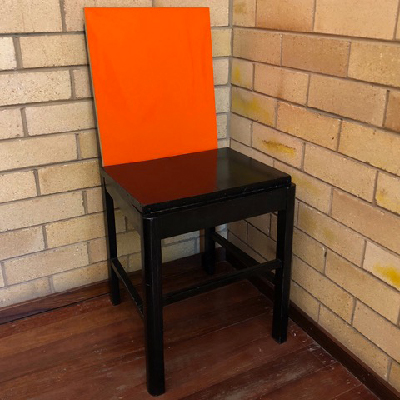
One And Three Chairs
25 July — 21 September, 2018
Pestorius Sweeney House, Brisbane
Joseph Kosuth’s ‘One and Three Chairs’ (1965) is perhaps the most well-known work of Conceptual Art. Comprised of a chair flanked by a life-size photograph of the chair and an enlarged facsimile of a dictionary definition of the word ‘chair’, it is a kind of updating of Rene Magritte’s famous painting ‘The Treachery of Images’ (1929). While the installation orchestrates an equivalence between the thing itself and its visual and verbal representation, it also at the same time highlights the disparities between them and, ultimately, the imperfect nature of language.
Kosuth would later apply the same display logic to several other objects, with, for example, the collection of the Art Gallery of New South Wales including his ‘One and Three Tables’. Which begs the question: What prompted the artist to initially select a chair, that most banal of utilitarian objects? Was it precisely this ordinary, everyday and ubiquitous quality that attracted Kosuth to the chair? Or did it signify something more? After all, the ‘one and three’ series includes a shovel, which surely hints at Duchamp’s famous readymade ‘In advance of a broken arm’ (1915).
These are some of the questions that this exhibition probes via the selection and disposition of artworks (by Gail Hastings, John Nixon, Heimo Zobernig, and Janet Burchill and Jennifer McCamley), each of which to a greater or lesser degree takes the chair as its subject, while a 1965 constructivist chair by the Brisbane architect Campbell Scott (1921-2007) rounds out and further complexifies the presentation.
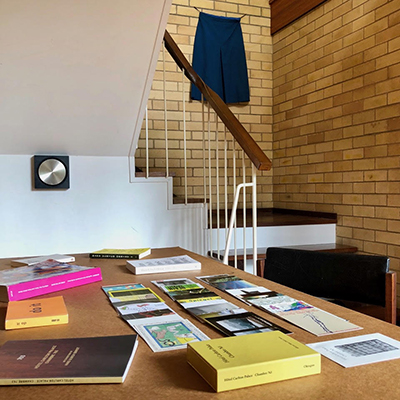
May 68
9 May — 16 June, 2018
Pestorius Sweeney House, Brisbane
On the 50th anniversary of the May 68 student protests in Paris we revisit this moment through the prism of the peripatetic Swiss curator Hans Ulrich Obrist, who himself turns 50 this month. Associated with the curator boom of the 1990s, Obrist and other high-profile exhibition makers of his generation were criticised for misunderstanding curating as “no longer separate from artwork but as a ‘cooler’ kind of art practice”. While this holds true for some, after more than a quarter of a century, HUO has transcended this criticism, his embrace of ever more diverse presentational possibilities and the sheer volume of his activities placing him in a league all of his own.
Of course, this diversity and output makes it difficult to fix upon just what it is that Obrist stands for and this too has drawn criticism. However, as those familiar with his early activities know, back then HUO subtly attributed a kind of cosmic significance to the fact that he was born in May 1968, that wild utopian moment when capitalism, consumerism and convention were the subject of serious challenge
Accordingly, for ‘May 68’ we present the boxed edition of artist’s postcards from HUO’s first Paris project, ‘Hôtel Carlton Palace: Chambre 763’ (1993), alongside other early publications by the curator, including his exhibition manual for ‘Do It’ (1995) and the Secession catalogue for his ‘Cities On The Move’ (1997) project, as well as some of his more recent books on the subject of curating.
In addition, the display will include artworks from the early 1990s by Andreas Exner (Frankfurt) and Leni Hoffmann (Düsseldorf), both of whom contributed related works to HUO’s Hôtel Carlton Palace installation and have regularly exhibited with us here in Brisbane over the last 25 years.
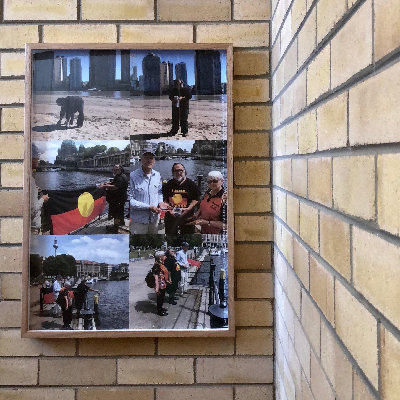
Dave Hullfish Bailey + Sam Watson
CityCat Project 2018
21 March — 28 April, 2018
Pestorius Sweeney House, Brisbane
Fifteen years ago the Los Angeles artist Dave Hullfish Bailey first visited Brisbane to conduct research for a public project in the city. After three weeks of intensive investigation the artist presented his initial ideas and proposals in a slide-lecture at Brisbane’s Institute of Modern Art. Amongst the proposals was a performance involving the unannounced deflection of Brisbane’s popular CityCat ferries at a location on Maiwar (the Brisbane River) and in a manner to be determined by local Indigenous stake-holders.
In 2006, following a drawn-out process of negotiation with the Brisbane City Council, the senior Aboriginal activist and writer Sam Watson realised the performance at a site of ancient cultural significance, but which was also, importantly, the 19th Century boundary of the city that Aboriginal people were not permitted to cross after dark. At a public forum the next day, Watson spoke of how the event had liberated the local Indigenous community, if only momentarily, from the shackles of colonisation. He then declared the performance a Dreaming and stated that it should be restaged from time to time into the future.
Parallel to the event on the river, which has been restaged in 2009, 2012 and 2016 (and is today known as ‘Maiwar Performance’), is a diverse body of material works, which is the outcome of a complex collaborative process involving not just Bailey and Watson, but also the Viennese artist Heimo Zobernig, who since 2006 has had a just-behind-the-scenes role in proceedings. This exhibition will include two of these tripartite works, both of which were created for the presentation of the project at the Galerie Nagel Draxler in Berlin in June 2017 and have not been shown before in Brisbane.
The first of these recent works is the video ‘Maiwar Performance’ (2017), which consists of edited documentation of all four events on the river since 2006, a news ticker text and overlaid positive/negative treatments by Zobernig. The other work is the Zobernig designed window poster for the Berlin presentation, which documents a traditional protocol action by Watson that saw him deposit a small amount of sand from Maiwar into The Spree as a mark of respect on arrival in a foreign place where he was about to undertake cultural business. It is typical of Watson’s work, which not only insists that traditional culture is still alive in our cities despite the brutal affects of colonisation, but also raises questions about the activities and practices of Aboriginal artists in places they have no blood connection to.
This project is supported by the Queensland Government through Arts Queensland.
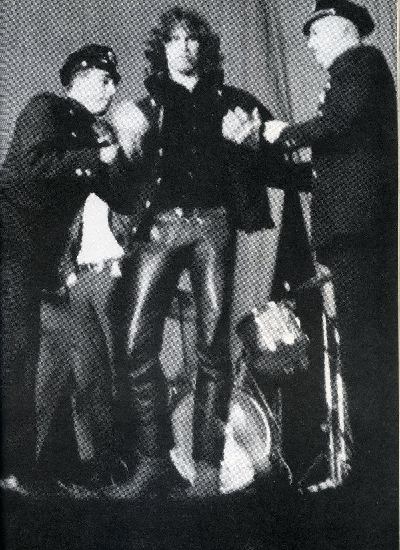
Tim Page: New Haven, 9 December 1967
9 December — 24 February, 2018
Pestorius Sweeney House, Brisbane
Opening Saturday 9 December 2017, 6pm
Saturday 9 December 1967 was a defining moment in rock history, one that pointedly upheld the burgeoning youth culture as a potent political force. With increasing opposition to the war in Vietnam and rising social inequality, rock became a vehicle for demonstration and dissent. Leading the way, of course, was Bob Dylan, while the Velvet Underground and the MC5 also took the new music into uncomfortable corners of the socio-political realm. The Doors, however, were the first group in rock history to have its singer, Jim Morrison, arrested mid-performance for ‘breach of the peace’.
What happened in New Haven on 9 December 1967 is well documented. In the course of one of Morrison’s signature mid-song monologues he described an incident just prior to going on stage when police spayed him with tear-gas. Earlier, in another monologue, the singer declared “We want the world and we want it NOW”. There was a real sense of urgency and purpose in Morrison’s pronouncements, with the event more like a political rally than a performance. The police, however, had heard enough. Riotous scenes followed, not only in the hall, but outside and back at the police station where Morrison was being held.
Brisbane artist Tim Page is best known for his work as a photojournalist in Vietnam in the 1960s. On 9 December 1967, however, Page was in New Haven covering The Doors show for Life magazine. Before being arrested himself on similarly trumped-up charges, the artist managed to capture Jim Morrison’s performance and arrest on celluloid. Fifty years later, Page revisits and reflects upon that moment when rock galvanised the masses and posed a serious challenge to establishment attitudes and values. While rock spent time in the wilderness in the 1970s, it rediscovered its mojo in punk. But where is that mojo today? With Capitalism more deficient and the public sphere more polarised than ever before, where is that voice of dissent now? These are just a couple of the questions that Tim Page’s exhibition wants to ask
Tim Page’s ‘New Haven, 9 December 1967’ is a boxed portfolio of five A2-format archival inkjet prints and title page on Hahnemühle paper, produced in an edition of 20 on the 50th anniversary of Jim Morrison’s arrest in New Haven on 9 December 1967.
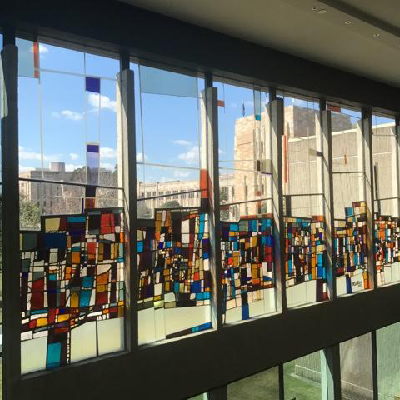
The Association of Friends of Nevil Matthews
7 October — 11 November, 2017
Pestorius Sweeney House, Brisbane
Opening Saturday 7 October, 5pm
Nevil Matthews (1930–2013) was one of the pioneers of modern art in Brisbane.
Between 1947–1951 Matthews attended the art school of the Central Technical College in Brisbane. He then studied privately with Jon Molvig and later with Clement Meadmore, while in 1957 he was involved in the initial push to establish the Queensland Branch of the Contemporary Art Society. In the 1960s, the CAS was the most advanced context for art in Brisbane and Mathews was an active member until its demise in 1973. Throughout this period he was also a regular exhibitor at The Johnstone Gallery, then Brisbane’s leading commercial dealer. Although Matthews’ hard-edge abstraction was at odds with the figuration that dominated the gallery’s program, its director Brian Johnstone, who was no fan of abstract art, nonetheless presented five exhibitions by the artist over the course of a decade.
By the late 1970s, Matthews, however, was only rarely exhibiting. The Johnstone Gallery had closed in 1972 and while there was a retrospective survey of his work at the Ray Hughes Gallery in Brisbane the following year and exhibitions at the Bonython Gallery in Sydney in 1972, 1974 and 1976, opportunities thereafter dwindled. With abstract art devalued, Matthews’ work found fewer supporters, and exhibitions in Brisbane in the 1980s went more or less unnoticed. For a time he painted seascapes.
In the 1990s Matthews stopped making art. For years apparently embittered by his situation, in 2006, however, he accepted an invitation to participate in TURRBAL-JAGERA: The University of Queensland Art Projects 2006, where he showed an 11 minute film of Mayne Hall (1973), now the University of Queensland Art Museum, under construction. Then, in 2009, in what would be his last exhibition, Matthews contributed one of his tondo paintings from 1978 to Queensland Art 2009, a polemical survey at the Pestorius Sweeney House that memorialised Vida Lahey’s Art in Queensland 1859–1959 on the occasion of its 50th anniversary.
Nevil Matthews was also, for the right students, an inspirational teacher. In the late 1960s he ran his own art classes and also taught in the architecture department at the University of Queensland. Then, in the 1970s, he taught at Brisbane’s Central Technical College and at the Darling Downs Institute of Advanced Education in Toowoomba, while in the early 1980s he was on the faculty of the Queensland College of Art in Brisbane.
This exhibition is the second and final Nevil Matthews memorial exhibition to be held at the Pestorius Sweeney House in 2017. It celebrates the formation of an association dedicated to preserving the artist’s legacy and focuses on a group of small sketches for the circle paintings Matthews made in London in 1967 and exhibited at The Johnstone Gallery in May 1969 accompanied by a brief interpretive text from architect John Dalton. In addition, the artist’s evocative 8mm film of Mayne Hall will be presented on video. A testament to Matthews’ close association with another celebrated Brisbane architect, Robin Gibson (1930–2014), the film reignites questions around authorship, not only of Mayne Hall but also other contemporaneous Gibson projects such as the Queensland Art Gallery.
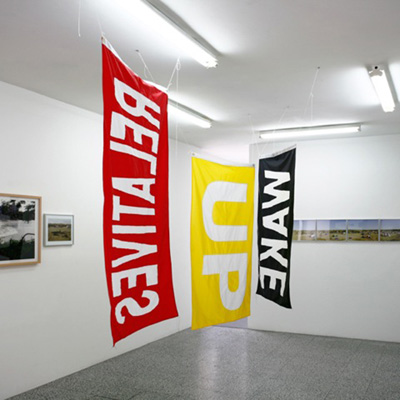
Australian Fine Arts at Spring 1883
6 — 9 September, 2017
The Establishment, Sydney
Australian Fine Arts/David Pestorius is pleased to announce its participation in this year’s edition of Spring 1883, with a selection of works from the CityCat Project, the ongoing (since 2006) collaboration between Los Angeles artist Dave Hullfish Bailey and Brisbane Indigenous community leader and writer Sam Watson.
In addition to the primary presentation in Suite 501, which will focus on Bailey’s 'call-and-response' engagement with Watson’s varying deployments of the Aboriginal flag in the CityCat Project, Watson will curate a film program for the foyer of The Establishment, the boutique hotel where Spring 1883 is held.
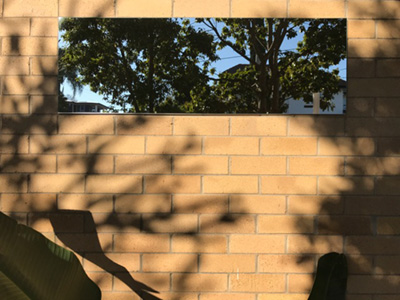
Paul Bai
29 July — 26 August, 2017
Pestorius Sweeney House, Brisbane
Opening Saturday 29 July, 3pm
An exhibition of recent work by Brisbane artist Paul Bai (*1968) will be presented at the Pestorius Sweeney House over the following month.
The venue is a place Paul Bai knows well, having had no less than six exhibitions here since 2001. The post-Miesian architecture of the Pestorius Sweeney House, with its exquisite flow of spaces and combination of materials also suits Bai’s reductive aesthetic, which the artist has sharpened via a deep interest in the theories and practices that emerged in the wake of Minimalism in the 1960s.
With the handcrafted object giving way to industrial fabrication and the ambulatory viewer, art became increasingly reduced, conceptual and, above all, concerned with the experience of real space and time. We see all of these things in the art of Paul Bai, which like the layering of images in a Sigmar Polke painting renders perception ambivalent and complicates the mental processing that accompanies it.
And as with Polke, a wry humour tempers the artist’s highly theorised investigation into the indeterminacy of spatial representation. Emblematic is Distance Between Two Points (3), 2017, a variation on a work Bai exhibited in New 15 at the Australian Centre for Contemporary Art. Comprised of two large black adhesive dots fixed to the wall with a portion of each dot peeled down from the top, it underscores the uncertain distance between two spatial marks, with the impossibility of an exact measurement of space.
Bai’s upcoming project will not only reflect his familiarity with the architecture and offer up a series of spatial conundrums that hint at a third or inbetween position, but also involve an echo of the previous exhibition by Erika Scott, which Bai curated.
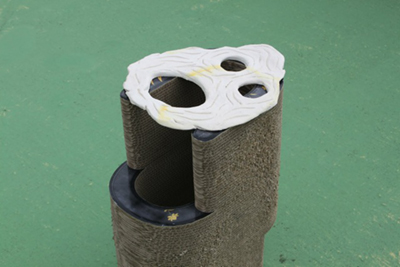
Erika Scott
22 April – 20 May, 2017
Pestorius Sweeney House, Brisbane
Opening 22 April, 2017, 6pm
David Pestorius is pleased to announce the first gallery exhibition of Brisbane artist Erika Scott, which will open at the Pestorius Sweeney House on Saturday 22 April.
It is sometimes hard to know what Scott is up to. Her project appears less an attempt to depict or make sense of the world than to double the chaos and confusion she finds there. Not since the emergence in the early 1990s of Sydney ‘grunge’ (Armanious, Cullen, Dwyer, et al.), have we seen such eccentric and compelling work. Visually anarchic and riddled with ambiguity, Scott’s collages, paintings and sculptures are also marked by a highly personalised physical involvement. Working with photo-prints, clay, found objects and furniture, the artist is constantly deconstructing and reconstructing her materials to create something that shifts between image and object, the organic and artificial, form and anti-form.
Scott studied at the Queensland University of Technology with Mark Webb, who until his recent retirement mentored successive generations of Brisbane artists from Gordon Bennett to Grant Stevens and beyond. Since graduating in 2009, the artist has produced works and evolved her distinctive sensibility via exhibitions and activities in diverse contexts and situations, mostly in Brisbane’s dynamic ARI spaces.
For Scott’s exhibition at the Pestorius Sweeney House, which is curated by fellow Brisbane artist Paul Bai, her work will find itself in an exquisite tension with the crisp geometries, material warmth and spatial nuances of the modernist architecture that will momentarily serve as its home.
For further information, please contact David Pestorius on (07) 3262 4870.
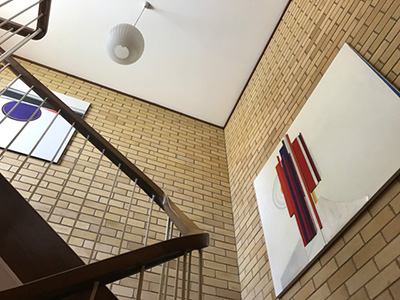
Nevil Matthews
1 March – 15 April, 2017
Pestorius Sweeney House, Brisbane
When the Brisbane artist Nevil Matthews died in early 2013 at the age of 82 there was no obituary, much less a memorial exhibition or retrospective.
Yet in the 1960s and 70s Matthews was perhaps Brisbane’s most successful and accomplished artist. Between 1963 and 1972 he had no less than five solo exhibitions at The Johnstone Gallery, the city’s leading contemporary art dealer of the time. It is an achievement all the more remarkable given that Matthews’ hard-edge abstraction was dramatically at odds with the antipodean nationalism that so defined the Johnstone’s program (not that one would get a sense of this from Nancy Underhill’s sentimental and shambolic recent account of the gallery). The artist also had several exhibitions with Kym Bonython in Sydney and at South Yarra Galleries in Melbourne.
While Matthews was essentially a painter, perhaps his greatest achievements were in the field of architecture and it is instructive that during the early 1960s he was close to the artist/designer Clement Meadmore, who was then living in Sydney. Matthews’ 1973 coloured-glass windows for Robin Gibson’s Mayne Hall (1973), now the University of Queensland Art Museum, are so well integrated that he could be credited as co-creator of the building. Indeed, Matthews and Gibson had a long and productive association. It is thought to have begun with the artist’s own home, the Matthews House (1958) in The Gap, and continued into the 1980s, with Gibson’s crowning achievement, the Queensland Cultural Centre (1982), said to be substantially indebted to Matthews’ drawings and advice. Needless to say, this is not how history records events.
Between 1966 and 1968 Matthews lived in London, where he knew the English painter Bridget Riley. His work Drop Through 4 (1967) betrays this association. Part of a large series of paintings and drawings shown at the Johnstone Gallery in 1969, their play with circles and abrasive opticality, but also the brief but evocative titles Matthews gave his London work, are all reminiscent of Riley’s approach.
In the 1970s, Matthews’ paintings became increasingly constructive, with the integration of diverse materials, including aluminium and coloured perspex. He also activated the diagonal in his painting and here too we are reminded of Riley. The Great Australian Totem (1970), is an example of the former, its title a dig at nationalism, our predominantly outdoor culture and worship of the sun.
Drop Through 4 and The Great Australian Totem are currently on exhibition at the Pestorius Sweeney House and can be viewed by appointment only until 15 April, while a group of Matthews’ painting sketches from 1967 will be exhibited later in the year in a further belated tribute to one of Brisbane’s most significant but now sadly undervalued artists.

Dave Hullfish Bailey + Sam Watson: CityCat Project 2017
15 March — 8 April, 2017
Australian Fine Arts/David Pestorius at Neon Parc, Melbourne
Neon Parc is pleased to announce the exhibition Dave Hullfish Bailey + Sam Watson: CityCat Project 2017, an ongoing collaboration (since 2006) between Los Angeles artist Dave Hullfish Bailey and Brisbane Aboriginal activist and writer Sam Watson. Presented by Australian Fine Arts/David Pestorius, the curator of the project, the show bridges indigenous concerns and political action across geographic borders.
Building upon works first presented at the Pestorius Sweeney House in Brisbane last December, the exhibition includes photo and text-based works created by Bailey in the aftermath of a visit in October 2016 to the camps near Cannonball, North Dakota, where Indigenous leaders and environmental activists came together to resist construction of an oil pipeline that has destroyed sacred sites and threatens supplies of drinking water. The exhibition features photographs of the Oceti Sakowin (Seven Fires of the Great Sioux Nation) encampment — where the Aboriginal flag flew proudly near the main entry — alongside archival images of the Aboriginal Embassy media event in Canberra in 1972. Through these juxtapositions, Bailey frames parallels between the birth of the Aboriginal land rights movement and the current resurgence of sovereignty issues raised in North Dakota.
The exhibition will also feature documentary photo and video works relating to Bailey and Watson’s collaborative Maiwar Performance on the Brisbane River (Maiwar). Staged in 2006, 2009, 2012 and 2016, the performance involves unannounced interruptions to the normal routing of Brisbane’s popular CityCat ferries to highlight the colonial past of the river and reintroduce indigenous narratives. The location of the interruptions is both the site of an ancient Dreaming story and also the colonial boundary that excluded Aboriginal people from the city after dark. Seen by Watson as an important act of Indigenous empowerment, the Maiwar Performance seeks to restore agency to the Indigenous people living around Brisbane by bringing past narratives alive within the community, and by projecting the possibility of a future not definitively determined by the recent past.
A question operating just beneath the exhibition is the ways in which the Aboriginal Embassy and the ongoing encampments in North Dakota can be understood as incubators of inter-tribal solidarity and emerging pan-aboriginal identities at national and international scales. Bailey explores these themes through text-based works, including flags which conjoin formal aspects of the Aboriginal flag with the sentence “Wake Up Relatives” used by leaders to muster the water protectors to pre-dawn prayers and front-line actions during his visit to North Dakota last October. In these works the distinctive and highly elemental design of the Aboriginal flag comes to the fore, posing a visual synecdoche for the movement from concrete circumstances and local traditions to unifying abstractions and symbols. Transposing its signature red, black and yellow colours as fields for language re-opens questions of relation to their modernist cousins. Against the rise of nationalist movements worldwide, the flags become a series of problem objects which ask viewers to reassess the modern project 100 years in, and perhaps to reconsider their definition of ‘relatives’ in much deeper frames of time.
Coinciding with the show will be a number of related events, including lecture/performances by Dave Hullfish Bailey at Monash University, Caulfield Campus on Thursday 16 March and RMIT Centre for Art, Society and Transformation on Friday 17 March, while on Saturday 25 March the Australian Centre for Contemporary Art will host the official launch of Dave Hullfish Bailey + Sam Watson: CityCat Project 2006–2016, edited by Rex Butler and published by the Sternberg Press. The launch by Aboriginal activist and historian Gary Foley will be preceded by a Q&A session involving Foley and Sam Watson, both of whom were key participants in the Aboriginal Embassy media event, and be mediated by Paola Balla, co-curator of ACCA’s current Sovereignty project.
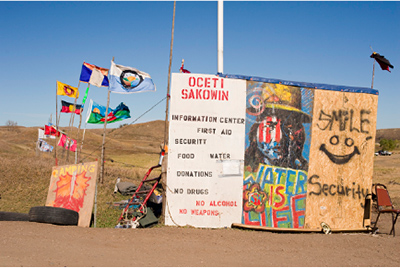
Dave Hullfish Bailey + Sam Watson: CityCat Project 2016
Performance: CityCat ferries, Brisbane River
3 December, 2016, 1–5pm
Exhibition: Pestorius Sweeney House, Brisbane
3 December 2016 — 28 January, 2017
Opening 3 December, 2016, 6pm
Pestorius Sweeney House, Brisbane
David Pestorius is pleased to announce the tenth anniversary staging of Maiwar Performance by Los Angeles artist Dave Hullfish Bailey and Brisbane Aboriginal community leader Sam Watson. Immediately following its original staging in December 2006, Watson, who is also a critically acclaimed writer, declared the performance to be a manifestation of the local Dreaming that should be periodically re-enacted into the future. This is the fourth occasion that the event has been staged.
The 2016 iteration of the Maiwar Performance, which may be experienced on CityCat ferries travelling between the West End and St Lucia terminals between 1–5pm on 3 December, will be accompanied by an exhibition of recent material works from the CityCat Project. The exhibition involves the complex juxtaposition of photo-works, including recent images of the camps at Standing Rock North Dakota, where representatives of over 200 First Nations are currently gathered in support of the Oceti Sakowin (Sioux Nation), whose sacred sites and water supplies are threatened by the construction of a nearby oil pipeline. Thought to be the largest gathering of the Sioux Nation since the Battle of the Little Bighorn against Custer in 1876, the camps and frontline actions acutely focus debates around the rights of Indigenous people over their ancestral lands.
In Bailey’s photographs of the Standing Rock camps, Harold Thomas’ Aboriginal Flag is seen flying proudly near the main entrance. Alongside these photographs, Bailey will present archival images showing Sam Watson at the Aboriginal Tent Embassy in Canberra in 1972 (generously provided by renowned Aboriginal activist and historian Gary Foley), while a third grouping of photographs document aspects of the 2012 iteration of the Maiwar Performance. Through juxtapositions of these images, Bailey frames parallels between the birth of the Aboriginal land rights movement and the current resurgence of sovereignty struggles at Standing Rock, while also positioning the Maiwar Performance within that larger context. In Bailey’s exhibition the Aboriginal Tent Embassy and Standing Rock encampment can also be understood as incubators of inter-tribal solidarity and emerging pan-aboriginal identities at national and international scales, with the distinctive design of the Aboriginal flag becoming a visual touchstone for the movement from concrete circumstances and local traditions to unifying abstractions.
The exhibition will open at the Pestorius Sweeney House at 6pm on Saturday 3 December and be open by appointment only until 28 January 2017.
The Maiwar Performance is generously sponsored by the Brisbane City Council.
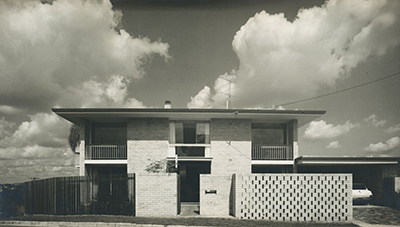
Drewe & Pestorius, Sweeney House (1966),
photo: Gabriel Poole, 1967.
50: Drewe & Pestorius’ Sweeney House
27 August – 26 November, 2016
Pestorius Sweeney House, Brisbane
Curated by Dr Andrew Wilson (Head, The Leeds School of Architecture), the exhibition 50: Drewe & Pestorius’ Sweeney House celebrates the 50th anniversary of the modern house that Brisbane architect Geoff Pestorius (1930–1968) designed for his brother-in-law Robert Sweeney. In a city that continues to fetishize the local ‘tin and timber’ vernacular building tradition and it’s dubious legacy, it is unusual to see Modernist masonry houses make it to fifty unscathed. Despite being more at one with the sub-tropical climate and evidencing a spatial sophistication that eclipses so much of what passes for domestic architecture today, these remarkable houses are still not singled out for heritage protection, but allowed to fall victim to rampant redevelopment.
Located on a modest corner block high on Hamilton Hill, the Sweeney House is perhaps the best surviving example of how post-war Brisbane architects adapted the lessons of the Bauhaus to local climatic and geographic conditions. Marked by an abundance of floor-to-ceiling glazing, house and garden blur into one another while the open-plan is a case study in cross-ventilation, natural lighting and spatial fluidity.
The important outdoor spaces of the Sweeney House, which were realised in cooperation with pioneering Brisbane landscape architect Arne Fink (1930–1993), reflect a balance of Indigenous, Oceanic and Asian species, with many of the original plantings still extant. Much of the original furniture also remains in situ and has been augmented with period pieces acquired locally from Danish Quality Furniture and the Craftsman’s Market, as well as rare constructivist chairs by Campbell Scott and a small pine table by Robert Dunlop.
The exhibition, which will be presented in the stairhall gallery (originally designed to accommodate Robert Sweeney’s art collection), will include original drawings, blueprints and vintage photographs taken by architect Gabriel Poole soon after the house was completed in 1966. In addition, a book by Leni Hoffmann with essays by Dr Wilson, Jonathan Kopinski and David Pestorius is being produced to accompany the exhibition.
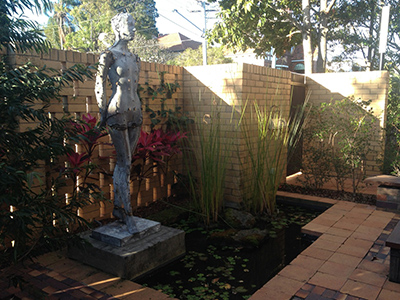
Heimo Zobernig
6 August – 3 December, 2016
Pestorius Sweeney House, Brisbane
If there was ever any doubt about Mies van der Rohe’s logic in choosing a life-size bronze for his Barcelona Pavilion (1929), it was resolved once and for all when Philip Johnson invited the architect to design the dust-jacket for the monograph accompanying his 1947 MoMA retrospective. For that small but significant commission, Mies chose a side view of the Barcelona courtyard animated by Georg Kolbe’s vampiric sculpture ‘Morning’, its hands shielding its eyes in an echo of the pavilion’s roofline, its generous overhanging eaves providing shaded respite from the bright Catalan sun.
It is hard not to see Mies’ selection of the Kolbe sculpture for his pavilion in Barcelona as a kind of architectural doubling. And not only on account of the revealing dust-jacket photograph. Two years after his Barcelona exhibition, Mies would again collaborate with Kolbe on a public display: his equally important, but less well-known, Berlin Exhibition House (1931). For that project, Mies also chose a Kolbe figure that served a mirroring function, it’s ambulatory form offering a clue to the radical spatial fluidity that so characterised the architect’s work.
Since 1999 Heimo Zobernig has visited and exhibited at the Pestorius Sweeney House in Brisbane on numerous occasions. Indeed, more often than any other artist, while his painted carpet for the living/dining room is now a permanent installation. Zobernig knows well the nuances of the house, with its walled court, pond, sculpture base, and, of course, its fluid open plan and blurring of inside and out, all taking their cue from Mies. For his 2016 exhibition, the artist puts this knowledge to use as he explores the place of sculpture in modern architecture, updating the intertwined story of Mies and Kolbe.
While Zobernig has for many years experimented with readymade mannequins, in 2015 he began to work in bronze, casting and conjoining male and female components along with 3D scans of his own head to create strangely androgynous beings. However, rather than cutting the casting sprues flush and sand-blasting the residue and welds to conceal the process, the artist toys with these aspects of finish in highly inventive and unexpected ways. And, as with other strands of the Zobernig’s vast oeuvre (think, for example, of his grid paintings that incorporate the masking tape into the work), a complex imaginative space opens up for the viewer, who, to follow the artist’s logic, finally ‘finishes’ the work.
Heimo Zobernig was born in 1958 in Mauthen and lives in Vienna, where since 2000 he has been Professor of Sculpture at the Academy of Fine Arts. He has participated in Documenta 9, 10 and 11, while in 2010 he was awarded the prestigious Kiesler Prize for architecture and the arts. In 2016, Zobernig’s architectural intervention for Josef Hoffann’s Austrian Pavilion at the 56th Venice Biennale was awarded the Roswitha Haftmann Prize, Europe’s best-endowed prize in the field of contemporary art.
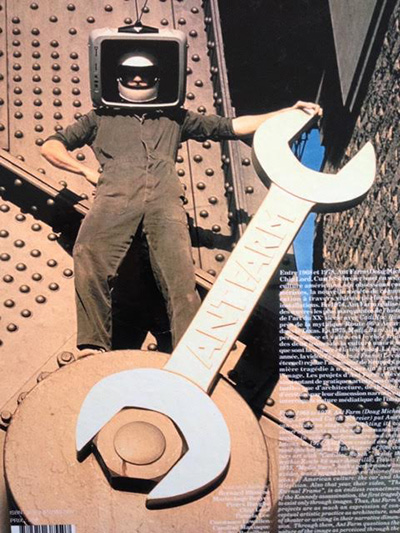
David Pestorius at Spring 1883
9 — 12 September, 2015
The Establishment, Sydney
David Pestorius is pleased to again announce his participation in Spring 1883, this year at The Establishment below Martin Place towards Circular Quay.
While this downtown Sydney locale is today associated with business, finance and politics, it hasn’t always been so. In the 1930s and ‘40s it was the epicentre of Sydney’s avant-garde, Grace Crowley’s studio situated just around the corner on George Street, one of many in the warren of buildings back up from the water. Then in the 1970s, after the artists had left, The Rocks was the backdrop to Ant Farm’s performance Ned Telly and The Golden Spanner (1976). Commissioned by the Nine Network's A Current Affair, it was set in the shadow of the Harbour Bridge and brought to Sydney the American conceptualists’ iconoclasm first seen the previous year at San Francisco’s Cow Palace when they presented their notorious Media Burn (1975).
Pestorius’ suite at Spring 1883 will conjure these moments with works by Ant Farm (San Francisco), Paul Bai (Brisbane), A.D.S. Donaldson (Sydney) and Melinda Harper (Melbourne).
In his work for the fair, A.D.S. Donaldson will show a new video/multiple, which brings together little known documentary footage of Crowley with the remarkable improvisations of Brisbane composer and guitarist Ed Kuepper (ex The Saints) performing around the quay at the Sydney Opera House.
For their part, Ant Farm will be represented by a rarely seen installation of Ned Telly and The Golden Spanner. Often exhibited as a video in Ant Farm retrospectives and surveys of media art (with Transmission: Legacies of the Television at the National Gallery of Victoria in Melbourne the latest instance of this), for Spring 1883 Pestorius will present The Golden Spanner itself, a sculpture last exhibited 40 years ago in the 1976 Biennale of Sydney at the Art Gallery of NSW.
Melinda Harper, on the other hand, one of the most innovative inheritors of the Crowley legacy, will be exhibiting a large painting, its wave-like composition a dizzying mix of colour that is both optical and material. That Harper is currently the subject of a mid-career survey at the Heide Museum of Modern Art, where in the hands of Sidney Nolan, Ned Kelly was first mythologized in paint, only enhances its shimmer.
Completing the presentation will be Paul Bai’s Other Side The Ocean (20004), a small painting that further animates the maritime theme running through Pestorius’ presentation for Spring 1883.
We look forward to meeting you at The Establishment in September.
For further information, please contact David Pestorius on (07) 3262 4870.
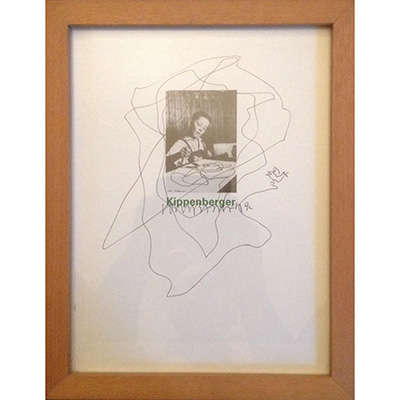
Martin Kippenberger in Sydney
4 June – 25 July, 2015
Pestorius Sweeney House, Brisbane
The week before Christmas, 1992, the German artist Martin Kippenberger was in Sydney. He had gone there to participate in The Boundary Rider: 9th Biennale of Sydney. You would be unaware of this, however, if you were to consult the myriad of literature about Kippenberger’s life and art published before and after he died in 1997. One of the most documented lives in art of the late 20th century, from his first survey catalogue Kippenberger (1997), published by Benedikt Taschen while the artist was alive, to the recently published initial volume of the catalogue raisonné of his paintings Kippenberger: Werkverzeichnis Gemälde IV: 1993-1997 (2014), there is not a single indication that the self-described “travelling salesman” was ever in Australia.
Yet Martin Kippenberger did go to Australia. At the Biennale of Sydney in 1992, then one of only four in the world, Kippenberger exhibited his photographic work That on tableproblem is hanging on the wall (1992), from the catalogue said to be part of the collection SUMAK, Tübingen. And while he was in Sydney he also completed nine drawings, each on a page of one of his remarkable and now famous artist books. A kind of free sample, the drawings range across the spectrum of his subjects and motifs from the ‘Little bird’ and ‘Fred the frog’ to portraiture and self-portraiture. Drawn then on a readymade of his own making, when they were completed they were given to the books’ owner, the Sydney artist A.D.S. Donaldson. These drawings, their gifting and his phantom trip to Australia in 1992, are the subject of the exhibition Martin Kippenberger in Sydney, curated by Donaldson at the Pestorius Sweeney House, Brisbane.
For further information, please contact David Pestorius on (07) 3262 4870.
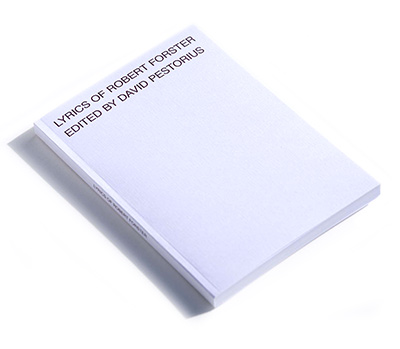
Lyrics of Robert Forster
Edited by David Pestorius
Cover by Heimo Zobernig
Kann-Verlag, Frankfurt
To celebrate the occasion of Heimo Zobernig’s 15 year survey of his Australian works, the artist has collaborated on the production of a limited edition artist’s book of lyrics by Brisbane singer-songwriter Robert Forster.
Edited by David Pestorius, the book is the first devoted to Forster’s lyrics and includes more than 50 songs from all phases of his now four-decade long career with The Go-Betweens (1978–1989; 2000–2006) and as a solo artist (1990–1999; 2006–).
The selected songs are grouped thematically under headings (eg. ‘Colour’, ‘Desire’, ‘Divide’, ‘Conquer’, ‘Contempt’, ‘Place’, ‘Point of View’, to cite just some), which serve to enhance the often oblique nature and interpretative potential of Forster’s lyrics. The book adopts a rough truth-to-materials approach, with the typography and layouts from original album sleeves and CD booklets redeployed where possible. The book also includes a brief biographical entry, a discography, and a small selection of illustrations that constitute a parallel narrative, which points up Forster’s historical engagement with artists and the world of art.
Lyrics of Robert Forster is published by KANN-Verlag, Frankfurt, 2015, 21 x 14.7 cm, b&w, 140 pages, perfect bound, with offset printed cover by Heimo Zobernig, in a limited edition of 120 copies. Copies of the edition are available from the publisher and from World Food Books.
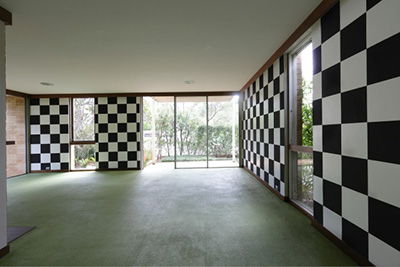
Heimo Zobernig in Australia 1999–2015
11 February — 25 April, 2015
Pestorius Sweeney House, Brisbane
On the eve of Heimo Zobernig’s spatial intervention for the Austrian Pavilion at the Venice Biennale 2015, David Pestorius is exhibiting a small survey of the Viennese artist’s work in Australia, a period which now spans more than 15 years.
Heimo Zobernig (* 1959) is one of the most important inheritors of the Minimal-Conceptual Art legacy. His work, which has had a central presence in Documenta 9 (1992), Documenta 10 (1997) and Documenta 11 (2002), traverses a broad range of media — painting, sculpture, architecture, installation, video, design, and many others besides — critically continuing the reflexive program of Modernism. Adopting an approach that is playful, confounds expectation and is sometimes hilarious, there is nevertheless one constant in his work: he is always chipping away at the modes and mechanisms of the art system as we experience it.
Since first travelling to Australia in 1999 to oversee the construction of a 36 metre long signage piece for Brisbane’s SouthBank Corporation, the artist has returned to participate in the Biennale of Sydney in 2004, the same year he collaborated with Ed Kuepper, co-founder of Australian punk group The Saints, on a video/performance that toured nationally and internationally. Zobernig was next in Australia in 2006 for a solo exhibition at Sydney’s Artspace, which surveyed his intense engagement with the early Minimal-Conceptual work of Sydney artist Ian Burn (1939–93). Later in 2006 Zobernig made another large signage piece in Brisbane, this time for the TURRBAL-JAGERA exhibition at the University of Queensland Art Museum, while in 2008 he designed a functioning bar — an aspect of the artist’s work cited by Nicolas Bourriaud in his influential text Relational Aesthetics — at the Institute of Modern Art for The Brisbane Sound exhibition. More recently, one of Zobernig’s projection screen sculptures was the centrepiece of Reinventing the Wheel: The Readymade Century at Monash University Museum of Art in Melbourne in 2013, while Brisbane’s MAAP–Media Art Asia Pacific presented a key Zobernig video/sculpture in its touring exhibition LandSeaSky: Revisiting spatiality in video art at venues throughout Australia and South East Asia in 2014-15.
This is a mere sampling of Heimo Zobernig’s work in Australia, but it amply demonstrates the depth and sustained nature of his engagement locally. Remarkably, Australia’s major art museums have felt unable to acquire the artist’s work. One can only hope that Zobernig’s Venice pavilion together with this exhibition will make clear the necessity to incorporate his work into our public collections.
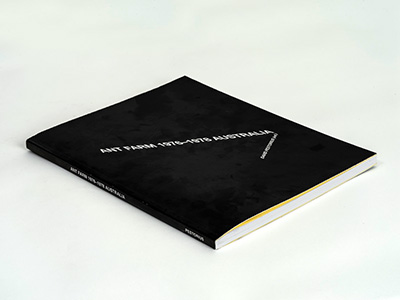
Ant Farm 1976–1978 Australia
16 August 2014, 5pm
David Pestorius at Spring 1883, Suite 130, Hotel Windsor, Melbourne
The San Francisco conceptualists Ant Farm (1968–1978) are famous for their radical architecture (The House of the Century, 1973), iconic land art (Cadillac Ranch, 1974), and pioneering video/performance (Media Burn, 1975).
Much less well-known are Ant Farm’s projects in Australia. Yet it is undeniable that their 10 week visit to Australia in mid 1976 turned the group upside down in more ways than one. Importantly, the focus of their work shifted, with Oceania not only becoming an important base, but also a critical concept for the group. Central to this shift was perhaps Ant Farm’s most ambitious project, the Dolphin Embassy (1974–1978), and in January 1977 the group’s co-founder Doug Michels moved to Sydney to establish a consulate there.
Until now, the historical accounts of Ant Farm have misrepresented and misunderstood the nature and extent of the group’s work in Australia. Equally, Ant Farm’s projects are invisible in any account of Australian art.
Ant Farm 1976–1978 Australia is the first book devoted to the activities and critical reception of Ant Farm in Australia. It adopts a form favoured by Ant Farm — the time-line/photo-collage/book — and critically builds upon their monumental artist’s book Dolphin Embassy (Log: 1976–1978), Sydney, Australia.
Ant Farm 1976–1978 Australia is published by KANN-Verlag, Frankfurt, 2014, 25 x 18 cm, b&w, photocopies, 155 pages, perfect bound, offset printed cover, edited by David Pestorius with cover by Liam Gillick, in an edition of 100 copies.
Ant Farm 1976–1978 Australia will be launched at Spring 1883 by Dr Edward Colless (Head of Critical and Theoretical Studies, School of Art, VCA), on Saturday 16 August at 5pm. After the launch, which is held in co-operation with World Food Books, all enquiries should be directed to the publisher.
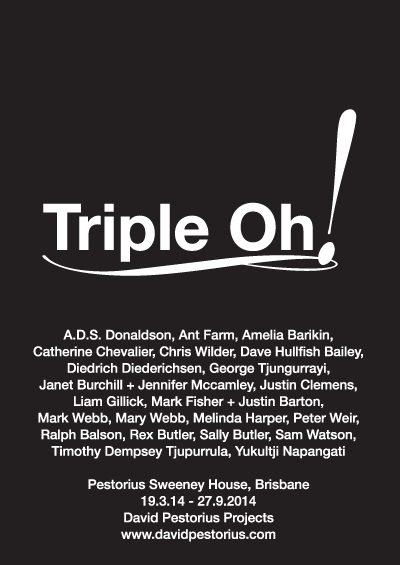
TRIPLE OH !
19 March— 27 September, 2014
Pestorius Sweeney House, Brisbane
It seems counter-intuitive to put together art — a form or medium dominated since Kant by questions of intentionality — and the object-oriented ontology arising out of the recent philosophical movement of Speculative Realism. However, undoubtedly one of the corollaries of Speculative Realism’s unchaining of ontology from “correlationism” — the assumption that reality must somehow correspond to human subjectivity and is only available to it — is the unchaining of art from questions of human intention and purposiveness.
Of course, in some ways this unchaining has been taking place in art since Pop and Minimalism, but at the same time these two movements (and post-modernism in general) have also been the occasion for an ever greater assertion of the artist’s intentions: from the “irony” of Warhol to the “meta-intentionality” recently theorised by Michael Fried in relation to Thomas Demand’s Pacific Sun (2011). TRIPLE OH! wants to rethink this break in the connection between art and the question of human subjectivity and proposes an experience that is alternately cosmic and unhomely, coming from the farthest reaches of the universe but also from close at hand.
Comprising a succession of displays that unfold over six months and concluding with a symposium, TRIPLE OH! will commence with a presentation of paintings by two of Australia’s pioneers of abstraction, Ralph Balson and Mary Webb (19 March—12 April). In the late 1950s, a time of extreme romanticism in art, Balson and Webb eschewed this sensibility, their work reflecting a world that no longer had humanity at its centre, but rather a universe of indeterminacy and change. Like the Aboriginal painting that emerged from Australia’s Western Desert in the 1970s, it speaks of a non-anthropocentric world in which consciousness is projected beyond the human and suggests other forms of knowledge and experience where man is no longer central to existence.
In line with these connections, the opening display will transition into an installation of more contemporary paintings by A.D.S. Donaldson, George Tjungurrayi, Melinda Harper, Timothy Dempsey Tjupurrula, and Yukultji Napangati, presented alongside a video monitor screening Peter Weir’s ineffable ‘Picnic at Hanging Rock’ (16 April—10 May). Then, on the evening of Saturday 17 May, Aboriginal activist and writer Sam Watson will read selected passages from his literary masterpiece ‘The Kadaitcha Sung’, as a prelude to the Australian premier of Mark Fisher and Justin Barton's haunting audio-visual essay 'On Vanishing Land'. Chris Wilder's 'Project Blue Book', which forged links between Ufology, Land Art, and post-Conceptual practices, will then be paired with documentation from 'The Dolphin Embassy', an experiment in trans-species diplomacy that was partially realized in Australia in 1976–77 by the collaborative art and design group Ant Farm (21 May—21 June). This will be followed by a site-related installation by Mark Webb that connects the past, the future and the domestic with the cosmic (25 June— 19 July), a room of shields by Janet Burchill and Jennifer McCamley (23 July—23 August), and, finally, a new photo-piece from Dave Hullfish Bailey's collaborative 'CityCat Project' (27 August—27 September). The project poster and graphic design are by Liam Gillick.
The TRIPLE OH! symposium is being organised in conjunction with The University of Queensland Art Museum where it will be held on 26–27 September 2014. The symposium program has been developed with Amelia Barikin (University of Queensland), Rex Butler (University of Queensland) and Justin Clemens (University of Melbourne), each of whom will give presentations, while the German cultural theorist Diedrich Diederichsen (Academy of Fine Arts, Vienna) will deliver the keynote address. Other presenters include Sally Butler (University of Queensland), Catherine Chevalier (May Revue, Paris), and A.D.S. Donaldson (National Art School, Sydney).
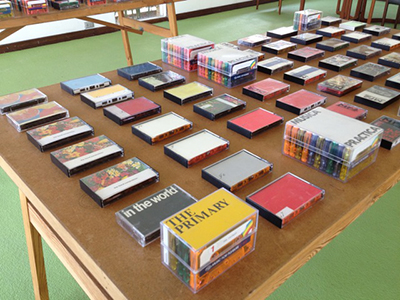
ANTI–MUSIC: 1979–1983
30 October—13 December, 2013
Pestorius Sweeney House, Brisbane
David Pestorius is pleased to present ANTI–MUSIC: 1979–1983, the most comprehensive retrospective of this important Australian artist collective, which in the early 1980s gained international recognition for its conflation of experimental music, punk and post-conceptual strategies.
An umbrella term for a large number of recording groups comprised mainly of artists with little or no musical training, ANTI–MUSIC was founded in 1979 by John Nixon, who also co-ordinated its activities over the five year duration of the project. Experimenting with a wide-range of musical genres, including folk, rock, pop, electronica, improv, film music, noise, muzak, and even opera, ANTI–MUSIC eschewed live performance, instead preferring anonymity and concentrating on DIY cassette-tape recording processes. Welded to all this was Pneumatic Drill, a publishing project initiated by Nixon in 1981 to elaborate the theoretical concerns of the enterprise. As with the recordings of ANTI–MUSIC, the Pneumatic Drill had many contributors, including Tony Clark, Paul Taylor, Peter Tyndall, Gary Warner, and Jenny Watson, to name just some of them.
During its lifetime, ANTI–MUSIC was presented in diverse forms and contexts, including Art Projects, V Space and the Clifton Hill Community Music Centre in Melbourne; the Institute of Modern Art (IMA), Q Space and Radio 4ZZZ-FM in Brisbane. In 1982 the project was included in Bill Wright’s Biennial of Sydney, the first time a large international survey of contemporary art — anywhere — featured a section devoted to recent tendencies in experimental music and sound art. Only a few months earlier, an ANTI–MUSIC sampler was released by the innovative English cassette-magazine Audio Arts. In 2004 this sampler was acquired by The Tate and can today be accessed on its website. While the vast body of work that is ANTI–MUSIC predominantly consists of master cassette tape recordings (here presented en masse in a display conceived by Nixon), two commercially available cassettes were produced in relatively small editions in advance of the Audio Arts release. In both instances, these cassettes were collaborations with Brisbane’s foremost post-punk groups The Go-Betweens and Out Of Nowhere, and included printed sleeves that featured graphics by Jenny Watson, Gary Warner, and Grant McLennan (The Go-Betweens).
Retrospective appraisal of ANTI–MUSIC came early with a survey of its proceedings having a strong presence in Know Your Product (IMA, Brisbane, 1986), Ross Harley’s pioneering account of ‘underground’ culture in Brisbane during the punk and post-punk years. Then, in January 1993, the IMA presented ANTI–MUSIC ‘in concert’ over two nights on a bill headlined by Robert Forster (The Go-Betweens). The project was next the subject of a retrospective survey in 1999 in the exhibition John Nixon: Music 1979–1999 at Berlin’s Künstlerhaus Bethanien, while, more recently, aspects of ANTI–MUSIC were included in The Brisbane Sound (IMA, Brisbane, 2008) and Melbourne >< Brisbane: Punk, Art and After (Ian Potter Museum of Art, Melbourne, 2010). Since these exhibitions a new generation has developed a keen interest in the recordings and presentational strategies of ANTI–MUSIC, thus underscoring the timely nature of this exhibition.
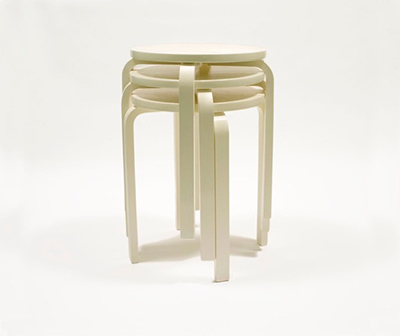
David Pestorius Projects at Sydney Contemporary 13
19–22 September, 2013
Carriageworks, Sydney
David Pestorius Projects is pleased to announce its participation in the inaugural edition of Sydney Contemporary between 19–22 September.
Australia’s new international art fair presenting modern and contemporary artwork, Sydney Contemporary 13 will present over 80 Australian and international galleries at the historical Carriageworks complex in Sydney’s inner-west. Underscoring this international flavour, the David Pestorius Projects booth will be dominated by the subtle, light-infused monochromes of New York painter Joseph Marioni (*1943). Described by the doyen of contemporary art criticism, Michael Fried, as "paintings in the fullest and most exalted sense of the word", Marioni's work was last shown in Sydney at the Art Gallery of New South Wales in 2001. Alongside the Marioni paintings at Sydney Contemporary 13, Pestorius will present a selection of recent and not-so-recent works by artists he has long been associated with, including Paul Bai (Brisbane), Dave Hullfish Bailey (Los Angeles), Janet Burchill and Jennifer McCamley (Melbourne), A.D.S. Donaldson (Sydney), Andreas Exner (Frankfurt), Jens Haaning (Copenhagen), Melinda Harper (Melbourne), Gerold Miller (Berlin), Mark Webb (Brisbane), and Heimo Zobernig (Vienna). Augmenting this selection will be a few carefully chosen surprises from the gallery stockroom.
An important feature of the display will be a number of limited editions, including a new multiple by Danish conceptualist Jens Haaning (*1965) that will have an especially reflexive dimension in the fair context. Hand-painted IKEA copies of Alvar Aalto's famous stacking stool, the Haaning multiple is undoubtedly a parody of the deluxe item and what Marx called the “fetish character” that normally attaches to art. At the same time, it appears to reassert the pre-eminence of the original over its copy, and will perhaps remind Sydney art audiences of a moment, not so very long ago, when the city made an important contribution to international debates around strategies of appropriation in contemporary art.
Finally, for the curated "Installation Contemporary" sector of the fair, Pestorius will present a new work by A.D.S. Donaldson (*1961). From the outside a more or less minimalist box, Donaldson's Abstrakt Kabinen (2002-13) functions at the overlap of the avant-garde's engagement with so-called little architecture — think El Lissitzky's Kabinett der Abstrakten (1926) or Oskar Schlemmer's Lackkabinett (1941) — and contemporary installation, although Donaldson's work is remarkably low-tech. On entering, a light comes on and the viewer is able to manipulate a number of sliding panels on which a small collection of abstract paintings is hung. They are thus able to arrange the space to their own liking and, once seated, enjoy the work at their leisure while a small exhaust fan extracts stale air. Interactive and straightforward, Donaldson’s work offers the viewer a radically intimate engagement with art and its structures.
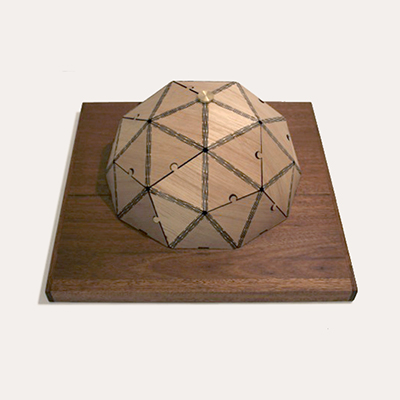
Gary Warner
3 August—14 September, 2013
Pestorius Sweeney House, Brisbane
David Pestorius is pleased to present an exhibition of new work by Sydney artist Gary Warner (*1957).
In the late 1970s, Warner was a central figure in Brisbane’s vital post-punk and avant-garde art scenes. At the time, he lived a kind of ‘art-life’ touched by the provocations of Dada, the Situationists, and, of course, Punk. However, unlike in New York and London, where Punk soon became confused with fashion and evolved into an academic musical genre, in Brisbane it was an act of resistance against a repressive State government and an ultra-conservative society with its retrograde art and culture. Warner’s early work, much of it collaborative, was the product of this grim situation. Functioning outside the institutionalised frameworks of official art (eg. galleries, museums, and contemporary art spaces), it took many forms, including mail art, ‘zines, record covers, artist pages, Polaroid photography, Super 8 film, and elaborate conceptually themed environments for performances by the important Brisbane post-punk group Zero.
Significant within the scope of Warner’s early work was an experimental music project known as Forced Audience. Inspired by the Cagean notion of “all sound is music”, Forced Audience was briefly affiliated with John Nixon’s Anti-Music, while in late 1981 it was included on a sampler released by the important English cassette magazine Audio Arts. Sound has continued to be an important locus within Warner’s creative practice and for his latest exhibition he will present ‘WoodWorked + SoundShell’, an hour-long soundscape meditation on the forest origins of timber and the work of making objects with wood. Derived from Warner’s library of field recordings, the soundscape is contained within, and emanates from, a small laser-cut plywood geodesic dome designed by the artist. A site-specific wall drawing, which incorporates custom-designed hub elements developed by the artist for construction of larger timber geodesic domes, will accompany the soundscape.
Gary Warner held his first one-person exhibition in August 1982 at One Flat Exhibit, the pioneering Brisbane artist-run space he helped establish together with Jeanelle Hurst and others. In April 1986, Peter Cripps commissioned a new installation by Warner for Brisbane’s Institute of Modern Art, while later that same year the artist returned to the IMA, where diverse aspects of his early work had a strong presence in Know Your Product, Ross Harley’s groundbreaking survey of ‘underground’ culture in Brisbane during the punk and post-punk years. Then, in 1989, together with long-time collaborator Adam Wolter, Warner took on the challenging Gallery 14 project space at the Queensland Art Gallery. Since those heady days, Warner has continued to maintain an independent studio, publishing, and exhibition practice, while his early work and its links to the contemporaneous production of John Nixon was surveyed in The Brisbane Sound (David Pestorius Projects/IMA, Brisbane, 2008), Melbourne >< Brisbane: Punk, Art and After (Ian Potter Museum of Art, Melbourne, 2010), and POLAROIDS: Post-Punk Photography in Brisbane 1979–1982 (Pestorius Sweeney House, 2012).
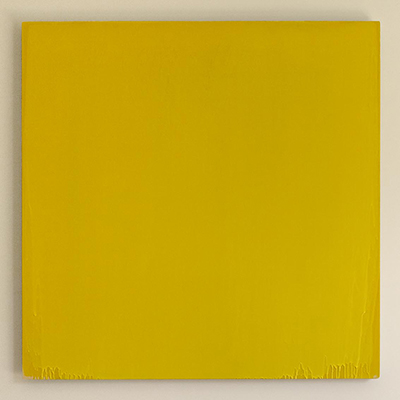
Joseph Marioni, "Yellow Painting", 2013, acrylic paint on linen on stretcher, 102 x 107 cm
Joseph Marioni
11 May— 20 July, 2013
Pestorius Sweeney House, Brisbane
David Pestorius is pleased to announce an exhibition of recent work by New York painter Joseph Marioni (*1943).
Joseph Marioni is one of the foremost contemporary exponents of a modern tradition in painting that has its roots in the Abstract Expressionism of the New York School. Seamlessly integrating the liquid paint of Jackson Pollock, the intense colour of Rothko and Newman, and the sensuous physicality of Clyfford Still, Marioni’s exquisite light-infused paintings demonstrate the ongoing vitality of an art grounded in the ‘truth to materials’ dictates of Modernism and the concentrated act of looking.
In 1998 Marioni’s most insightful and eloquent critic, Michael Fried, described his monochromes as “paintings in the fullest and most exalted sense of the word”, while, more recently, he declared Marioni to be “the strongest painter of whom I have knowledge at work anywhere today.” They are remarkable claims that only someone with Fried’s own exalted status as a critic could make. For his Brisbane exhibition, Marioni is showing two new paintings, one a bush green colour, the other a golden yellow. Made with the predominantly glazed gallery of the Pestorius Sweeney House in mind, these jewel-like paintings will ‘come alive’ amidst the abundant but constantly changing natural light of the room. Indeed, as Fried has observed, there is something “almost Eastern” about Marioni’s paintings, which can be expected to resonate strongly with the Japanese-influenced International Style architecture and related garden design. The painter’s exhibition also continues a theme running through recent shows at the Pestorius Sweeney House, one that activates questions around nationhood, its colours and their codes.
Joseph Marioni first caught the attention of the international art world in 1975 with a solo exhibition at Artists Space, New York, selected by Brice Marden. In the 1980s, he was one of the leaders of a movement known as Radical Painting and was closely associated with the pioneering German gallerist Rolf Ricke. This period reached its apotheosis in 1988 with a solo exhibition at the Städtisches Museum Abteiberg, Mönchengladbach, while the 1990s were marked by important surveys of his work at the Kunsthalle Baden-Baden (1995), Vienna Secession (1996) and the Rose Art Museum at Brandeis University (1998). In 2000, Marioni was included in that year’s Whitney Biennial, a show that was soon after followed by the painter’s first solo exhibition in Australia at the UQ Art Museum in Brisbane. Marioni’s most recent museum show was in 2011 at The Phillips Collection in Washington, D.C., while a room of his paintings is currently on display (until 23 June) in the two-artist exhibition Marioni/MacPherson, curated by Rex Butler at the UQ Art Museum.
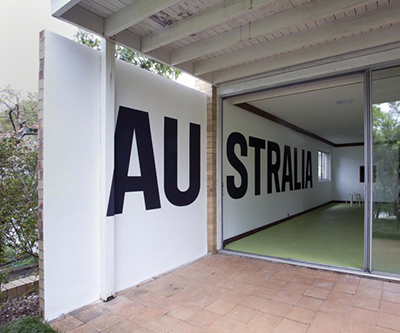
Jens Haaning
2 March-27 April
Pestorius Sweeney House, Brisbane
David Pestorius is pleased to present a new exhibition by Copenhagen-based artist Jens Haaning (*1965).
Central to Haaning’s project is a socio-political dimension that is highly conceptual, non-didactic, and often Zen-like in its simplicity and degree of abstraction. The artist opens up to analysis the structures of modern society and the dynamics of power via key themes, including immigration, racism, intercultural dialogue, nationalism, and the relation between global capitalism and local economies.
Since 2004, Haaning has painted the name of the country in which he is exhibiting on gallery walls in giant black capital letters. The effect is intriguing: the typography appears anonymous yet has been specially designed, and at over a metre high with nothing else on display in the gallery, it has a strangely commanding presence: a bit like encountering a mirror, one feels self-conscious confronted by our own sense of place, history, and the here and now. Haaning’s ‘Australia’, however, has a very particular resonance, coming as it does when questions around Indigenous sovereignty, immigration, and ‘Islamisation’ (rendered acute by the recent visit of controversial Dutch politician Geert Wilders), are increasingly in the public consciousness. For Brisbane, Haaning will tap into this moment, extending the ‘Australia’ wall beyond the limits of the gallery. The end result is deliberately confusing — it appears as if the builder of the house has misread the plans — and serves to complexify the inside/outside experience of the International Style architecture and associated sense of transparency and openness, which is so indebted to Modernist ideals of the public sphere.
Jens Haaning emerged in the 1990s as part of the so-called ‘Nordic Miracle’ — the most widely exhibited generation of Scandinavian artists in history. Closely associated with Nicolas Bourriaud’s ‘Relational Aesthetics’, Haaning was included in Traffic (CAPC Bordeaux, 1996), the exhibition that launched the phenomenon, as well as several of the influential curator’s more recent projects. Haaning first travelled to Brisbane over a decade ago to participate in Parallel Structures (David Pestorius Projects, Brisbane, 2001), where he realised the intra-city light bulb exchange now in the Sammlung Haubrok, while the following year a related work was included in Documenta 11. In 2004 the artist was again in Australia, this time to participate in the Biennale of Sydney, while in 2004–05 he collaborated with one of the ‘Godfathers’ of Punk, Brisbane guitarist Ed Kuepper (The Saints, Nick Cave and The Bad Seeds, etc.) on a performance that toured internationally, including to the Foundation Cartier in Paris and Vienna’s famous Burgtheater and Film Museum.
Since 2007, Jens Haaning has had important solo exhibitions at the Whitechapel Gallery, London; Secession, Vienna; Institut d’art contemporain, Villeurbanne/Lyon; and the San Francisco Art Institute. The artist’s last solo exhibition in Brisbane was at the Pestorius Sweeney House in May 2003, when he removed the gallery windows only to re-install them facing ‘inside out’. The current project has been generously sponsored by the Danish Agency for Culture and PGH Bricks + Pavers.
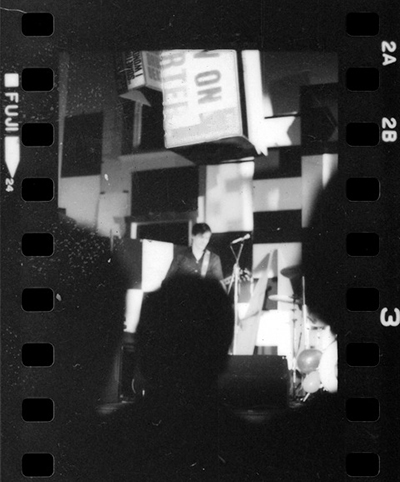
Another Time
26 January—23 February
Pestorius Sweeney House, Brisbane
In the early 1980s it was not uncommon for performances by Brisbane’s post-punk groups to be accompanied by elaborate conceptually themed environments. Another Time is structured around one such event. Held at the Baroona Hall on July 4, 1980, "The Sincerity Ball" featured several groups, including Zero, The Go-Betweens and the Four Gods (the so-called ‘Brisbane Sound’), and a visual polemic that took its cue from the black and white check motif deployed by the 2-Tone label groups (The Specials, Madness, etc.) as code for the racial diversity and musical hybridity that so defined this highly politicised milieu.
Brisbane has undergone many changes since 1980. Back then it was ruled by an authoritarian State government, which subjected Indigenous Australians, but also those involved in the emerging post--punk culture, to brutal treatment at the hands of its police force. This was the context that saw the 2-Tone check explode into life via wall paintings, tattoos, shaved heads, and black-and-white dress. From the ceiling hung illuminated constructions made out of newspaper day bills, their hyperbolic pronouncements serving to further dramatise the situation. And, finally, there were the Super 8 films of Gary Warner (*1957), one of the architects of the event. Screened as Zero performed, Warner’s films functioned as a kind of expanded cinéma vérité, documenting and intervening in the apparently madcap activities of those both on stage and off. Frequently sped-up, recalling the slapstick of Charlie Chaplin, they speak of a carefree existence brim-full of humour and poetic moments: a life, in other words, wildly at odds with the otherwise grim reality that was Brisbane circa 1980.
In 1987 the art historian Urszula Szulakowska surveyed the intensely collaborative practices of Brisbane artists over the previous decade and saw in them a Dadaistic impulse, something increasingly considered critical to relational and participatory art today. It is therefore timely that we remember "The Sincerity Ball", but also because the questions it was asking, all those years ago, are still with us. That the exhibition commences on Australia Day is designed to render those questions more acute.
Another Time has been realised in close co-operation with Gary Warner whose Super 8 films for performances by Zero would later feature in Know Your Product (IMA, Brisbane, 1986), Ross Harley’s pioneering survey of crossovers between art and popular culture in Brisbane during the punk and post-punk years. Since then they have been presented in The Brisbane Sound (IMA, Brisbane, 2008), Queensland Art 2009 (Pestorius Sweeney House, Brisbane, 2009–10), and, most recently, in Melbourne >< Brisbane: Punk, Art and After (Ian Potter Museum of Art, Melbourne, 2010), where the installation here first began to take shape. Another Time also builds on Dave Hullfish Bailey’s recent exhibition of works from his collaborative CityCat Project and includes works from that show, as well as contributions from Liam Gillick, Anne Wallace, and Heimo Zobernig.
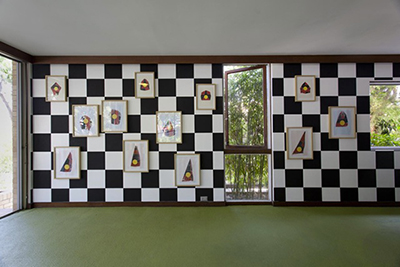
Dave Hullfish Bailey—CityCat Project 2012
Pestorius Sweeney House
Exhibition (8—29 December)
CityCat ferries, Brisbane River
Performance with Sam Watson (8 December, 1–5pm)
Pestorius Sweeney House, Brisbane
Roundtable with Sam Watson, Ian McLean, Michele Helmrich, and Rex Butler
For his series of variations on Harold Thomas’ (Aboriginal) flag, Proposals for some possibly useful reconfigurations (2011), Dave Hullfish Bailey was inspired, he says, by the 18-foot skiff, the ‘Aberdare’, which used technological innovations (and profits from the Aberdare Colliery near Ipswich) to dominate racing on the Brisbane River in the 1930s. What Bailey proposes is a possible set of sails for its descendants on today’s televised racing circuit, each of which would be composed of a cut-up and re-ordered version of Thomas’ flag. We have a small spinnaker for running, which is when a boat sails downwind with the wind behind it. We have a larger asymmetrical spinnaker for reaching, which is when the boat sails across or perpendicularly to the wind. And we have a jib or headsail for beating, which is when the boat engages in successive tacks back and forth in an attempt to sail into the wind. Bailey first came across the story of the ‘Aberdare’ through research stemming from his 2006 CityCat Project, a collaboration with Indigenous activist and playwright Sam Watson. In his Project, Bailey worked with Watson to have the Brisbane ferries at one point of their route momentarily veer off course, slow down and face Aboriginal actors standing in the Boundary Street Park, a historical landmark for the local Turrbal and Jagera people. Importantly, Watson hung a large version of Thomas’ flag at the site, which is significant not only for its Kurilpa Dreaming but because it lies on the historical curfew line that prohibited Aboriginal people from entering the city after dark. (Here those three sailing terms, “running”, “reaching” and “beating”, can also be understood to describe the interaction between the Indigenous population of Brisbane and the new European colonisers.)
Of course, looking at Bailey’s 22 paper collages, we cannot but be struck by the obvious iconoclasm of his Proposal, almost in the literal religious sense. The burning or defacement of the flag, if not always strictly illegal, is usually heavily proscribed in most cultures, with the destruction of an enemy’s flag being the ultimate act of political contempt and opposition. So what is it that gives Bailey, who is a white artist from Los Angeles, the right to destroy this flag by Thomas, an Aboriginal man, who has moreover had such difficulty first of all asserting his copyright over the design and then enforcing his legal rights over it? What allows Bailey to think that he has anything to contribute to the cause it is seen to stand for by displaying it in these various sail-shaped formats in an art gallery? Undoubtedly the negotiation of the permissions to make and display Bailey’s altered versions is one of the actual subjects of the work, one of the things that, after a while, we become conscious of while looking at it. (This is just as in the CityCat performances the passengers would gradually have become aware of the co-operation or even “reconciliation” between the ferry driver and the actor standing on the shore, whose actions are necessarily synchronised, even if they could not actually see them signalling to each other.)
But – to pick up the analogy to sailing that the work proposes – we might indeed think of Bailey as the wind that animates Thomas’ flag. Bailey in cutting up the flag might appear to destroy it, but in fact his act queries how it might travel further, how it might occupy sites – real, historical and ideological – the original might never otherwise have got to.7 He merely continues that process of dissemination that is already at play from the very moment that Thomas made his flag and gave it to others to fly. At that point any original meaning it might have had was lost as it became a boat – a kind of Argo – that others could sail in. And, indeed, for Bailey – who was a keen sailor in his youth – the wind always does have something of this utopian dimension about it. In his 2001 Schindler Shelter project, he not only created sail-like structures covered with maps in a style that recalled Malevich’s Suprematism, but reconfigured the architect R.M. Schindler’s famous Kings Road House in West Hollywood to resemble a community shelter after a natural disaster by bending bamboo trees down on one side with sheets to form temporary shelters. The sail for Bailey is always the sign of a certain openness, a receptivity to the future, an ability to respond to unknown circumstances and make the best of them.
Edited excerpt from “The Wind in his Sails” by Rex Butler.
Dave Hullfish Bailey (*1963) lives in Los Angeles, where he teaches at Art Center. The artist's approach to investigating sites is focused upon how geography, physical infrastructure and social narratives of emancipation intersect in specific places. His performative staging of research mobilizes standard tools of intellectual enlightenment (empirical inspection, historical contextualization, scientific analysis, etc.) alongside more heuristic techniques including language games, experimental mappings, re-purposed logical machines, and hypothetical scenarios. What emerges are narratively experimental and critically reflexive super-ecologies, characterized by active feedback loops between two already complexly organized systems: the internal ‘signal’ of the place, and the ‘noise’ of the attempt to describe it. Recent exhibitions and projects include the 30th Sao Paulo Biennial (2012); For the blind man in the dark room looking for the black cat that isn’t there (Contemporary Art Museum St. Louis, ICA London, De Appel Amsterdam, and other venues, 2009-10); Surrounded by Squares: Dave Hullfish Bailey and Nils Norman, Raven Row, London (2009); Lyon Biennial 2007; What’s Left to its own Devices (On reclamation), Casco Office for Art, Design and Theory, Utrecht (2007); and CityCat Project, Brisbane (2003/ongoing). Recent publications include the exhibition catalog Elevator (Secession, Vienna: 2006) and the artist’s book What’s Left (Casco/Sternberg Press, Utrecht/ Berlin: 2009).
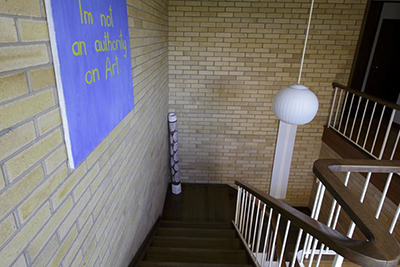
REPAINT
8–22 December 2012
Pestorius Sweeney House, Brisbane
Following the renovation of the central stairwell at the Pestorius Sweeney House, the exhibition REPAINT will dramatise this space with five paintings by five artists who emerged in the wake of the ‘crisis in painting’ precipitated by Minimal Art in the 1960s.
The earliest and perhaps the most significant is a hollow log coffin by Maningrida artist England Bangala (1925–2001). Leaning casually in a corner that marks the true centre of the house, Larkan, c. 1988, signals the important role Aboriginal art has played in the renewal of painting after Minimalism. The dynamic forms of Bangala’s painted pole also echo the circular experience of the space, with its subtle colours, textures and distinctive serpentine handrail carved out of Queensland maple by local master craftsman Robert Dunlop.
The Sydney artist A.D.S. Donaldson (*1961) also adopts a severely vertical format with Untitled, 1995. However, the association is as much to Barnett Newman as it is to Aboriginal art. If the format appears to underscore the verticality of the paint image, Donaldson also manages to question a certain orthodoxy in the ‘truth to materials’ dictates of modern painting. Using thinned liquid pigments, Donaldson’s mode of production is both wholly manifest and almost impossible to discern and even suggestive of industrial fabrication.
The paintings for the space of car windows by Frankfurt artist Andreas Exner (*1962) also bring the industrial object into tension with the handmade. Only provisionally a monochrome, Exner’s Saab 900 1988 Turquoise Blue Light Studio Lascaux, 2006, bears the trace of a second colour and the vehicle that prompted it.
Untitled (I’m not an authority on art), 1989, by Melbourne artist Elizabeth Newman (*1962) also confounds our experience of it. A subtly crafted blue monochrome overlaid with the brief textual pronouncement of its subtitle in faux-naïve script, Newman’s painting both lauds and criticises modern painting and the complex rhetoric that surrounds it.
Finally, Untitled, 2006, by Heimo Zobernig (*1958) is a similarly ambivalent undertaking. A white monochrome, its pure surface projects the idealism and utopian promise of modern painting. Closer inspection, however, reveals a more complicated scenario. As with many of the Viennese artist’s paintings, a coloured masking tape is used not so much to achieve a perfect finish, but to raise questions about finish and the role of the viewer.
REPAINT also wants to remember the Malcolm Enright curated exhibition Minimalism X Six (Institute of Modern Art, Brisbane, 1983), a critical moment in the evolution of Minimal Art in Australia. On the afternoon of Saturday 22 December, Enright and Minimalism X Six artist Jenny Watson will cast their minds back to that moment almost 30 years ago when Minimalism, having embraced the lessons of Conceptual art, began to engage with the ‘return to painting’ of the early 1980s.
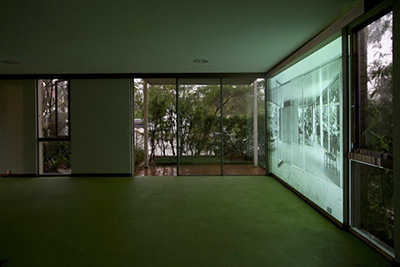
SARAH MORRIS: Points on a Line
3 November 2012, 4–9pm
Pestorius Sweeney House, Brisbane
The Farnsworth House, Plano, Illinois and the Glass House, New Canaan, Connecticut. Philip Johnson and Mies van der Rohe. Curator and architect. Architect and architect. Points on a Line, 2010, directed by artist Sarah Morris (*1967) documents a shared desire to build structures that might change the way we think about a house, a form and a context. These two buildings were the result of shared ideas and collective desire. But they also complicate ideas of the copy and the original and the chronologies of Modernism.
The two buildings demonstrate a legacy of focus upon details and surface – inside and outside. Capturing the tension of ego and authorship in precisely deferring architectural statements. By carefully documenting the daily maintenance of these two buildings and lingering over the precise placement of the structures in space and of objects within each structure, we are presented with a clear view of places that have gone beyond their initial use and become the intersection of a dialogue that was both personal and professional. Morris's deployment of cinematic codes in relation to architectural precision produces images that go beyond a record of functionality or the streamlining of needs. These are places that remain elusive despite their openness – structures that are open vessels where we search for markers of the corporate aesthetic to come and the legal wrangles that marked the struggle to complete and maintain them. Buildings that require constant representation and new documentation in order to recode and understand what came before and what came next. Obtaining complete unrestricted access for each location of the film, Morris has woven together art, architecture and corporate image production with flowers, the behavior of bees and the patterns of butterflies — window washing, cooking, power-broking and collecting.
Morris filmed at both sites over the course of several months, among other locations including The Four Seasons Restaurants, the Seagram Building, Mies van der Rohe’s infamous Lake Shore Drive, and Chicago’s Newberry Library. Morris utilizes The Four Seasons, a place that Philip Johnson practically used as his personal office, as the meeting point between the two architects. Ultimately, Points on a Line is a record of preservation of two structures and a document of power plays that left a mark in the pragmatic idealism of the late modern period.
Sarah Morris lives and works in New York City. She has widely exhibited internationally, with solo exhibitions since 2005 at the Museum für Moderne Kunst, Frankfurt; Museo d'Arte Moderna, Bologna; Fondation Beyeler, Basel; Museum Boijmans van Beuningen, Rotterdam; Moderna Museet, Stockholm; and Palais de Tokyo, Paris. This space-related installation of Points on a Line will be the first time the work has been presented in Australia.
This project has been organised in co-operation with the Centre for Architecture Theory Criticism History at The University of Queensland and will be preceded by a number of short presentations, including Alexandra Brown on Superstudio, 9999, Radical Architecture, and the S-Space Mondial Festival in November 1971; Andrew Leach on Reyner Banham and the question of quality in contemporary architecture; David Pestorius on the calculated misrepresentation of Ian Burn and his work in official Art & Language histories; and Andrew Wilson on colour in the work of Brisbane architects Hayes & Scott.
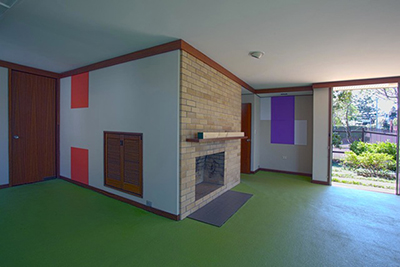
PAUL BAI
22 September—27 October 2012
Pestorius Sweeney House, Brisbane
Pursuit of the immaterial has a long tradition in visual art. Simone Martini's 14th Century Annunciation, for example, made the presence of the Holy Spirit palpable by delineating a distinct negative space between the Virgin Mary and the angel bringing her tidings. 20th Century artists sought to represent the immaterial through abstraction and by forms of reduction. In the 1960s, artists such as Mark Rothko, Barnett Newman and Ad Reinhardt used both these strategies to address a spiritual dimension and Yves Kline painted shiny monochromes whose deep virtual space evoked a metaphysical realm that he termed ‘the void’. Frank Stella’s black paintings and the sculptural installations of Carl Andre, on the other hand, emphasised pure materiality. However, both sets of experiments finally led to conceptual art in which the physical appeared to become redundant.
Adopting many of the tropes of minimalism and conceptual art, Paul Bai contributes to this tradition an insistence that the immaterial is also material. Constantly, his work asserts that concepts depend on a physical infrastructure and that, equally, physicality is dependent on concepts and therefore on ideological circumstances in the real world. Something like this was arrived at by artists such as Joseph Kosuth and Lawrence Weiner in the late 1960s and ‘70s when they equated concepts with language. But Bai goes a step further. Drawing on the insights of theorists such as Manuel Castells, Bai finds that physical space today is as interdependent with conceptual space as language was for Kosuth and Weiner.
For example, painting green monochromes at each end of length of timber instead of on a flat panel, Bai forces us to traverse the space between the ends in order to perceive the work. The distance is real rather than ‘virtual’; the viewpoint taken by the observer is always relative rather than absolute; yet the work itself constitutes a single concept without which the viewer’s action would be absurd. Simultaneously, the fresh length of timber and its little leaf-green monochromes allude to diminishing natural resources rather than to art per se as would the Greenberg-inspired tradition that Bai appropriates.
Bai’s works remind us that the 21st Century world is one in which place and space are in a state of flux both conceptualised and real, making it difficult to distinguish one from the other.
Text: George Petelin
Paul Bai was born in Tianjin, China in 1968. He migrated to Australia in 1988 and graduated with a Bachelor of Visual Arts (Honours) from the Queensland College of Art in 1992. Bai first came to artworld attention in 1998 when he collaborated on the infamous Alderton Gallery performance. He has since embraced a range of collaborative possibilities, including designing posters for the Austrian artist Josef Strau and participating in the projects of Melbourne duo Burchill/McCamley. Bai has also had several solo exhibitions in Australia and overseas, including at the Institute of Modern Art in 2002.
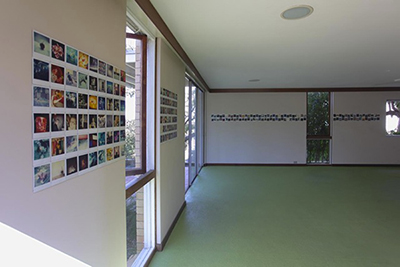
POLAROIDS: Post-Punk Photography in Brisbane 1979–1982
21 July—25 August 2012
Pestorius Sweeney House, Brisbane
On the 30th anniversary of POPISM (National Gallery of Victoria, 16 June — 25 July 1982), the contemporary survey often said to mark the inauguration of appropriation art in Australia, Polaroids: Post-Punk Photography in Brisbane wants to celebrate an aspect of that important exhibition that has almost been forgotten.
The brainchild of Paul Taylor (1957-1992), the young Australian art critic who would later curate the first survey of work by Punk impresario Malcolm McLaren (1946–2010), POPISM is remembered for the brash quotational painting of the time. That the exhibition also challenged traditional notions of authorship via works with more discernable links to Minimalism and Conceptual Art has been largely overlooked in retrospective assessments. One such work was a double-line of 100 Polaroid photographs by The Society For Other Photography, an art project initiated by John Nixon (*1949) in Brisbane in 1980. Featuring 'found' images alongside those taken by the artist, Taylor wrote of how it offered “no single perspective; the realm of the photographic is extended way beyond personal vision to absorb the uncharted and anarchic aspects of cultural visibility.” Seen in the work's multiple genres — still-life, portrait, landscape, abstract, architecture, documentary, etc. — this was underscored by its non-hierarchical composition and Minimalist installation, which drew the viewer in close and rendered them physically active.
John Nixon's interest in Polaroid photography was developed in close dialogue with Gary Warner (*1957), a key figure in Brisbane's experimental art and Post-Punk music scene. Nixon and Warner collaborated on several art, music and film projects in the early 1980s, however, it is their work with a Polaroid SX70 camera that best encapsulates this time. Both artists were attracted to the immediacy and intimate format of Polaroid photography, as well as its intensely saturated and painterly colour. Perhaps of greatest significance was its democratic 'available to all', 'non-art' character. Like the contemporaneous use of Super 8 film or the canvas boards of Jenny Watson, Imants Tillers and Tony Clark, Polaroid photography was coded as amateurism, signaling a concern to deskill and to find new and unexpected possibilities beyond fine art orthodoxy. Or, as Taylor observed, these artists were “in an antagonistic relation to the existing fine-art system.”
This anti-establishment imperative, which had its roots in the ethos of early Conceptual Art, also played a critical role in shaping Post-Punk music. Indeed, the Polaroid photography of Nixon and Warner not only points to shared concerns, it also speaks of a common creative milieu, with portraits of members of The Go-Betweens, The Apartments, and Four Gods (the so-called 'Brisbane Sound'), equally present in the mix with portraits of Taylor and Watson, Peter Tyndall and Mike Parr, Lindy Lee and Mark Titmarsh and, of course, the artists themselves.
Since those heady days, Nixon and Warner have continued to experiment with the photographic medium. It is, however, truly remarkable that this exhibition, which features hundreds of images, is the first time their Polaroid work has been brought together and shown in the city that first prompted it.
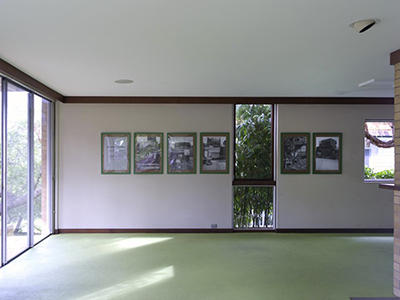
BURCHILL|MCCAMLEY
21 April—2 June 2012
Pestorius Sweeney House, Brisbane
David Pestorius is pleased to present a new exhibition by Janet Burchill (*Melbourne, 1955) and Jennifer McCamley (*Brisbane, 1957).
Since 1992, the artists have been documenting the changing usage and urban status of a site in Kreuzberg, Berlin where the Berlin Wall had formerly run. At this site, a Turkish-German family had planted an outdoor vegetable and flower garden and constructed a number of sitting and garden structures. The artists were struck by the modernist art tropes (Bauhaus especially) and it’s beauty as a sculpture assemblage. Over the years Burchill and McCamley have made several works relating to this site and its documentation: photographic series, slide works, videos, sculptures and drawings. This exhibition will present, for the first time, Bethaniendamm 0, 2003, a specially framed limited edition portfolio of 6 offset prints from this work group.
Accompanying Bethaniendamm 0, 2003, will be a small selection of other photographic work including from the artists’ Feld und Funktion series: Feld und Funktion (Hook of Holland), 1995, which is a replay of Bas Jan Ader’s Pitfall On The Way To A New Neo-Plasticism, Westkapelle, 1971, and Feld und Funktion (Berlin), 1995, a staging in front of Mies van der Rohe’s famous Neue Nationalgalerie, Berlin.
Janet Burchill and Jennifer McCamley have been working both individually and collaboratively since the early 1980s. Their practice embraces a wide variety of media including photography, film, drawing, sculpture and painting. Throughout Burchill and McCamley’s combined career, they have critically engaged with the history and forms of modernist art and its relationship to everyday life, as reconsidered through feminist, psychoanalytic, filmic and spatial discourses. Collaboration has also been an important aspect of their practice. Recent exhibitions include Colombo Art Biennale, Sri Lanka (2012), A Different Temporality Aspects of Australian Feminist Art Practice 1975-1985, Monash University Museum of Art, Melbourne (2011), The Phantasm, Foxy Production, New York (2011), and Light From Light, MAAP, Brisbane (2010).
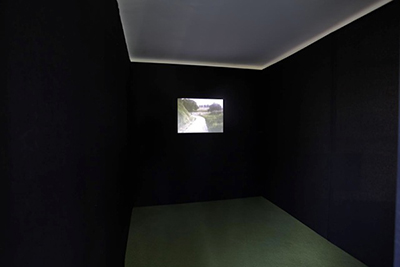
LOUISE BENNETT
9 March—7 April 2012
Pestorius Sweeney House, Brisbane
David Pestorius is pleased to present the first gallery show by Brisbane artist Louise Bennett (*1985).
Working predominantly in video performance, Bennett combines digital and hand-made processes to enact a playful tension between everyday experience and its representation. Adopting a lo-fi, do-it-yourself approach, the artist's videos, recorded on an iPhone, could almost be YouTube fodder. Yet there is always a twist to the scenarios she spins, always something that elevates the situation out of its apparent banality.
Bennett's most recent video, Traces, takes on landscape, a genre that dominates art in Australia like no other. For artists to critically engage with landscape today they must address this dominance and the discourse surrounding it. Tahiraj does this, firstly by substituting new media processes for painting. She then confounds traditional perspective: there is no unobstructed wide view here, while the artist is very much inside the landscape rather than a detached observer of it. There is also nothing particularly spectacular about the view. Recorded at dusk, light is fading fast. Soon there will only be darkness, with the outlines of the topography all that remains to be sketched.
There is a simplicity and a lightness of touch in this video that is compelling. If Bennett is here playfully alluding to the redundancy of the landscape genre, she is also pointing to the value of lived experience and to an art that functions within the fabric of life rather than as an illustration of it.
All of this is lent emphasis through the screening of the video in a specially constructed black-box. Oriented so that its point of entry is not immediately apparent, it initially presents as an autonomous object, a bit like one of Tony Smith's Minimal sculptures. In the process, architectural space is activated and a hyper-awareness of the indoor/outdoor setting generated.
Louise Bennett attended the Queensland University of Technology where she studied with Mark Webb. In 2009 she graduated with a Bachelor of Fine Arts (Honours) and has since been a key participant in Brisbane’s lively ARI scene, exhibiting at and organising shows for spaces such as Accidentally Annie Street and Boxcopy, to name just two of the more well-known enterprises.
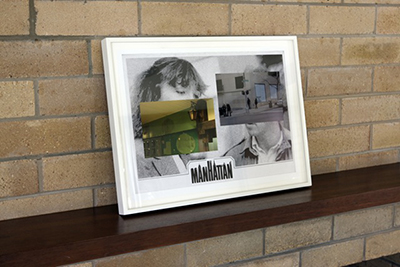
SOME RECENT NEW YORK VIDEO
16—18 December 2011
Pestorius Sweeney House, Brisbane
Curated by Robert McKenzie and in its title connected to the twin exhibitions of American and Australian art that toured this country in 1973, Some Recent New York Video presents the work of Ellen Cantor (*1963, Detroit), Danny McDonald (*1971, Los Angeles), and Ken Okiishi (*1978, Ames, Iowa).
Each a participant in the New York art scene, these artists and film makers work in an experimental tradition, inheritors of a pedigreed history that stretches from Andy Warhol and Jack Smith through to No Wave cinema, Charles Atlas, and Laura Cottingham, to name just a few of their forbears. Their immediate social and geographic scenario is the art worlds of New York, London and Berlin, and this is used as a ground against which narratives are constructed. Necessarily improvising, they conflate real stories with an hallucinatory allegorical other world. The use of friends and associates as actors amplifies this confusion, which carries with it ghosts of a "scene".
For each of the artists that essential cinematic term "location" is key. Cantor, whose video takes as its subject the lives of five children growing up under the rule of Chilean dictator Pinochet, deliberately recasts her story by shooting it in London and New York. These other cities, we become aware (one of the film's recurring themes is,“is tragedy a choice?”), are standing in for Pinochet's Chile and are themselves imprinted with this history.
McDonald’s video, produced in conjunction with an exhibition at Berlin's Isabella Bortolozzi Gallery, was premised on his inability to be present at the show. Sent in his place is the drag acid casualty Mindy Veil. From another time and head-space, Veil must try in vein to get together a satisfactory exhibition for the Berlin audience. Failure, in its conventional sense, is brought into sharp relief and the concept of a 'frame of reference' is elegantly relativised.
In Okiishi’s video, location is also paramount. Riffing on the reciprocal fascination between the art worlds of New York and Berlin, he uses his friends, his own biographical engagement with the cities (he is often described as living and working in both places), and famous representations of these places (in the form of Woody Allen's Manhattan) to understand and experience how it is; as he has said, that “Manhattan is translated through Berlin and back again.”
On Sunday, 18 December, 5—7pm, curator Robert McKenzie will be joined by Catherine Chevalier, founding editor of the Paris-based May Revue, to discuss some of the themes that emerge from the exhibition. As well, the Sydney artist A.D.S. Donaldson who will present 'There is no Provincialism Solution', a paper co-authored with Brisbane art historian Rex Butler.
Robert McKenzie is an artist, writer and curator who has lived in New York since 2008. He has worked as an artist and curator under the name "Slave" (2004–2006) as well as publishing the art fanzines Slave and Sandwich, while in 2009, with Paul Foss, Rex Butler and others, he co-authored The Ampersand Files: Art & Text 1981–2002. McKenzie's last curated project in Brisbane was the Slave exhibition Freedom for Prosperity at the Pestorius Sweeney House in 2005.
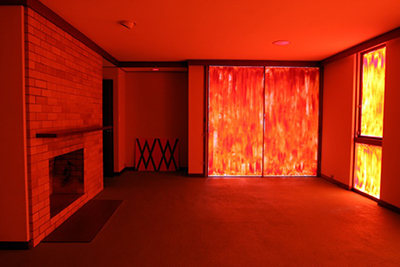
MARK WEBB
28 October—19 November 2011
Pestorius Sweeney House, Brisbane
David Pestorius is pleased to present a new exhibition by Brisbane artist Mark Webb (*1957).
The exhibition follows on the heels of the artist's 25 year survey at the same venue last year. Where that show presented diverse works and foregrounded Webb's role as teacher and mentor to the post-Bjelke-Petersen generation of Brisbane artists, his new exhibition is more situational in nature.
Critically responding to Heimo Zobernig's painted green carpet, a semi-permanent architectural intervention realised in the immediate aftermath of Webb’s survey show, the artist will paint red the windows of the predominantly glazed space to effectively create a two-colour painting that envelops the viewer and adds a new dimension to the painterly tradition of hinterglasmalerei. Webb's deployment of red and green, a combination traditionally associated with colour blindness, will turn that affliction on its head and, in the process, render reflexive the context and its history, including artists and artworks recently exhibited there.
Webb's artistic concerns have always revolved around ideas of play and recontextualisation. With his latest exhibition he will extend further these strategies, opening up, often in unexpected ways, the symbolic range of associations that the colour red can have, but also demonstrating how those associations are shaped by a particular context and moment in time.
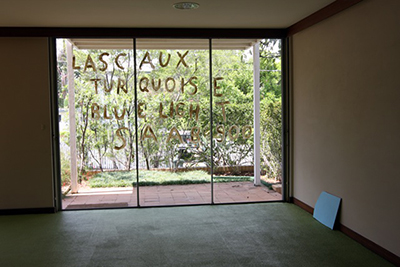
ANDREAS EXNER
17 September—8 October 2011
Pestorius Sweeney House, Brisbane
David Pestorius is pleased to announce the return to Brisbane of Frankfurt artist Andreas Exner (*1962).
Much of Exner's material production falls to be considered within 'the extended field' of painting, which is to say that it exceeds the conventions of painting, but is still somehow recognisable as evolving the tradition in a critical way after the schism of Conceptual Art. Exner's clothing pieces, which brought the artist to prominence in the early 1990s, are a prime example. These works, with their subtle colour combinations, have a strange and compelling presence, however, this is not so much attributable to Duchamp's readymades, but to Russian Constructivism and its quest for a kind of quasi-functionality. And like the artist's more recent paintings for car windows, they continue the literalisation of Ellsworth Kelly's shaped canvas, bringing it into a more productive engagement with our everyday existence.
Andreas Exner first visited Brisbane for an exhibition at the David Pestorius Gallery in 1996. The artist has since returned to Australia on several occasions for exhibitions and to see friends and family, often for extended periods. While Exner's career is mainly in Europe, with its vast exhibiting and other networks for art, over the last two decades he has developed very real ties to Australia. Following his Brisbane show, Exner will travel to Melbourne, where he will be artist-in-residence at the VCA and have an exhibition at its Margaret Lawrence Gallery.
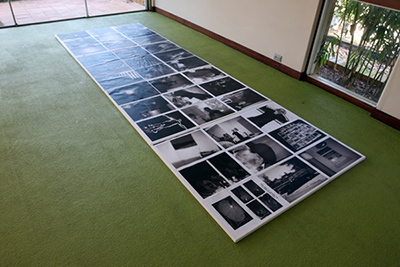
PETER BONDE
20 August—10 September 2011
Pestorius Sweeney House, Brisbane
David Pestorius is pleased to present a new exhibition by Copenhagen artist Peter Bonde (*1958), the artist’s first solo show in Brisbane since 1997.
For over three decades Bonde has challenged the conventions of painting in a truly critical way. Emerging in the immediate aftermath of Conceptual Art, his work bends unpredictably under the weight of art history and the contemporary media overload.
Bonde also continues something of a local tradition, one that acknowledges the important role of Danish artists in the Situationist International (Asger Jorn) and Fluxus (Henning Christiansen, Erik Anderson, etc). The anti-authoritarian provocations of these international art movements echo loudly in Bonde’s work. For him, the material forms of art, it’s appropriate subject matter and modes of display are always in question. Repeatedly defying notions of good taste and decorum, his work foregrounds highly personal aspects of daily life, touching on subjects that tend to go unspoken. What shines through is a psycho-social dimension, which is utterly contemporary and generates an empathy in the viewer.
There is one other important constant in Bonde’s work and that is the principle of collage. Perhaps the most salient development in art over the last century, Bonde has contributed to the evolution of collage, not just through his irreverent ‘in your face’ approach, but also for the way he has integrated new media processes and materials. For his latest exhibition, the artist will update, daily, a large multi-panel collage first shown at the UQ Art Museum in TURRBAL-JAGERA: The University of Queensland Art Projects 2006. And as with other recent exhibitions at the Pestorius Sweeney House, Bonde’s new show will also engage with Heimo Zobernig’s painted floor, a semi-permanent architectural intervention that exerts a strong presence on the space.
In the late 1980s, Bonde was based in Cologne, which was then an important centre for contemporary art. There he and compatriot Claus Carstensen paved the way for a new generation of internationally ambitious Danish artists such as Olafur Eliasson, Superflex and Jens Haaning. Like them, Bonde has exhibited widely, including several times in Australia since 1990 when he participated in Rene Block’s memorable Biennale of Sydney. The artist is perhaps best known, however, for ‘The Snowball’, his 1999 collaboration with the Jason Rhoades (1965–2006) for the Danish pavilion at the 48th Venice Biennale, while in 2002 his work was featured in Vitamin P: New Perspectives in Painting, an important international survey by Phaidon.
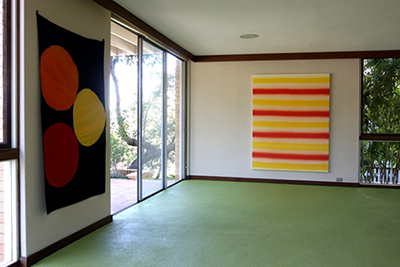
A.D.S. DONALDSON
8 June—9 July 2011
Pestorius Sweeney House, Brisbane
David Pestorius is pleased to announce a new exhibition by Sydney artist A.D.S. Donaldson (*1961).
For over two decades, Donaldson has been one of the foremost exponents in Australia of a critical post-Conceptual abstraction. It is a practice that is historically self-conscious, experimental, multi-disciplinary, playful, straight-forward and open to chance. Importantly, it also encourages a kind of aesthetic receptivity to the mundane and almost overlooked aspects of everyday life. To this extent, Donaldson’s work has been seen as an extension of Fluxus and in 1993 he was included alongside Robert MacPherson, Peter Tyndall and others in the Queensland Art Gallery exhibition FLUXUS and after … Allied to all of this is an engagement with what we might call ‘Aboriginal Abstraction’.
Donaldson's new exhibition will be broken into four parts, with the opening installation (8—12 June) exemplifying what Donaldson has described as the “continually evolving dynamic between the work of contemporary abstract painters and that of indigenous Australian artists.” This part, whose focus is on painting, also includes a fabric work created by Group Otto but, significantly, it also includes a small screenprint from Tim Johnson's ‘Radio Birdman’ series. Johnson was Donaldson's teacher in the early 1980s and the presence of his work here acknowledges his importance to Donaldson and indicates the very Sydney-specific lineage this work comes from.
For the second part (15–25 June), Donaldson will present a small exhibition of the work of Mary Webb (1901-1958). This will be the first time in more than 60 years since Webb's work has been seen in public in Australia. Little-known in this country, Webb was a Sydney trained artist who exhibited at the highest levels in Paris during the 1950s and was our most successful and accomplished mid-century avant-gardist and our pioneering collage artist. Webb was also the conduit to post-war Paris for Grace Crowley, Ralph Balson and Frank Hinder and it was through her that they all appeared in Michel Seuphor’s Dictionary of Abstract Painting (1957) and Balson was able to hold his only overseas exhibition (of his radical ‘Matter Paintings’) at Galerie Creuze in Paris in 1960. Raymond Creuze had been Webb’s last gallerist and the suggestive cloud-like abstract paintings in this exhibition were shown first by him in her final exhibition only weeks before her untimely death in December 1958. Over the last decade, Donaldson has conjured Webb in a range of ways, including by exhibition (most notably in 21st Century Modern: 2006 Adelaide Biennial of Australian Art) but also by essay and more recently by dissertation. This, however, will be the first time that the artist has curated a small show of Webb’s informel or nuagist abstraction, an event which, more importantly, will be the first occasion since 1950 that the work which brought her to such prominence in Paris has been seen in the country where she first made her reputation.
For the third part (29 June – 2 July), Donaldson will continue his series of minimalist floor constructions known as the ‘Greens’. Made from grass-green painted sheets of glass supported by timber beams, these low-slung floor works function at the overlap of painting and sculpture. Like mirrors, the surfaces of the glass reflect the architecture of the space around them, casting the world all green. This will be Donaldson’s fifth Green, the latest in a series that commenced in Sydney in 1995, was followed by a second Green in Sydney in 1998, a third in Copenhagen in 2000, and a fourth in Brisbane in 2002.
For the fourth and final part (6–9 July), Donaldson will show a group of recent memorial paintings based on the work of the Brisbane painter Gerald Ryan. All but invisible today, Ryan exhibited with the Queensland Art Society before moving to Sydney during the years of the Second World War where he befriended Sydney’s leading artists and joined the Contemporary Art Society in whose exhibitions he showed. Crucially, he participated with Balson, Crowley and Frank Hinder in the seminal 1944 exhibition Constructive Paintings at the Macquarie Galleries, an exhibition that placed him at the forefront of art in Australia at this time. Ryan, however, is today almost entirely absent from our local, let alone national, art historical accounts. In raising the figure of Ryan, Donaldson, in effect, both asks questions as to who is missing, or might also be missing, from our standard accounts but as well answers who might be included were another narrative to be written, one that could see our art made up through the inter-connections between our cities. Donaldson hopes through this work to bring Ryan to life, to bring him back as it were, and perhaps in this way the exhibition might lead to us being able to see a ‘real’ Gerald Ryan. In the meantime we will have only Donaldson’s Ryans.
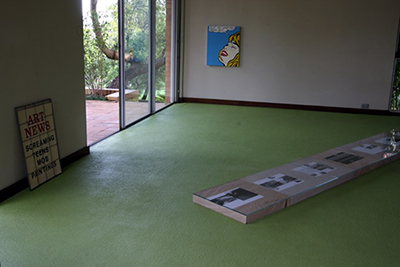
GRAVE BUT NOT SERIOUS
1 April—7 May 2011
Pestorius Sweeney House, Brisbane
Opening on Friday 1 April, David Pestorius will present a thematic exhibition dedicated to the idea of Aboriginal humour and its manifestation in contemporary art and culture.
In his famous Boyer Lectures ‘After the Dreaming’ (1968) W.E.H. Stanner recalled an exchange with an elderly Aboriginal man whose tribe was facing extinction. Reflecting upon his predicament, the old man said “When all the black fellows are dead all the white fellows will get lost in the bush, and there’ll be no one to find them and bring them home.” The observation was related dispassionately — there were no “tears, reproaches or dramatics” — and the old man went off laughing. According to Stanner, this was exemplary of Aboriginal humour, “a wonderful gift, one they did not get from us, of taking us gravely but not seriously.” Today we see something of this gift in the works of Richard Bell (Brisbane), Destiny Deacon + Michael Riley (Melbourne/Sydney), Tracey Moffatt (Brisbane), and Archie Moore (Brisbane), presented here. At once both frightening and funny, this disarming humour is generally understood as the product of a continuing effort to come to terms with white Australia. The exhibition also features Indigenous playwrights John Harding (Melbourne) and Sam Watson (Brisbane), whose works reflect a similar sensibility, while a new piece from Watson’s ongoing collaboration with Dave Hullfish Bailey (Los Angeles) is presented alongside the ABC television spoofs ‘Basically Black’ (1973) and ‘Babakiueria’ (1986). In the process, a long and proud tradition of Aboriginal activism that embraces the agency of satirical culture is alluded to.
In scheduling the exhibition opening for April Fools Day — a day when practical jokes are tolerated — the present moment is reflexively activated in a ploy first utilised locally by another great humorist, the Melbourne artist Peter Tyndall. In 1980 Tyndall set his exhibition at the Institute of Modern Art in motion in this way, yet the show itself was a savage indictment of the repressive socio-political and cultural situation in Brisbane at the time. In a similar inversion, the artist’s mock newspaper daybills (‘SCREAMING TEENS MOB PAINTINGS’) from this important exhibition, one of which is included here, pit the solitude of the art gallery experience against the intense communal response that popular music can generate. It is a sensibility perhaps not so very different from the one that Stanner was trying to describe.
Finally, on Saturday 7 May, Sam Watson and art historian Rex Butler will discuss aspects of the exhibition in situ.
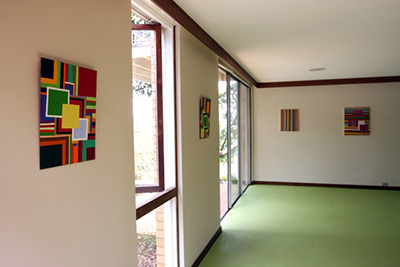
MELINDA HARPER: Important Early Paintings
26 February—26 March 2011
Pestorius Sweeney House, Brisbane
The small oil paintings that marked the emergence of the Melbourne artist Melinda Harper (*1965) in the late 1980s occupy an increasingly important place in the history of abstract art in Australia. Executed on rough off-cuts of masonite or the cheap mass-produced canvases of amateur painters, these complex and exquisitely coloured compositions of stripes, squares and rectangles defied their otherwise impoverished materiality. They also functioned in a critical relation to the grand-scale of American-type painting, which had dominated abstract art internationally for decades.
Since that time, Harper’s kaleidoscopic paintings have been included in all of the important surveys of geometric abstraction in Australia, the most recent being Cubism & Australian Art at the Heide Museum of Modern Art in late 2009. They seem to channel, by turns, Mondrian and Malevich, the Delaunays and Otto Freundlich in Paris in the 1930s, Ralph Balson and Grace Crowley in Sydney in the 1940s (in 1999 Brisbane critic Rex Butler nominated Harper as “the great inheritor of Balson and Crowley”), the Op Art experiments of Bridget Riley, Gene Davis’ stripe paintings, and the work of teachers and colleagues such as Robert Jacks, Lesley Dumbrell, John Nixon and Tony Clark. Yet for all of these points of reference, Harper’s paintings are fully her own and resolutely contemporary, something that is borne out in the observation of Los Angeles critic Jeremy Gilbert-Rolfe that they capture something of “video’s thin brightness.”
Probably the greatest influence on Harper’s work, however, has been ‘Aboriginal abstraction’ and her paintings are at the forefront of perhaps the most consequential development in contemporary art in Australia, what the Sydney artist A.D.S. Donaldson has identified as “a continually evolving dynamic between the work of contemporary abstract painters and that of indigenous Australian artists.” From the outset of her career, Harper has derived inspiration from the formal and technical aspects of central desert painting, something that has been recognised in key exhibitions showcasing this tendency, including Spirit + Place: Art in Australia 1861–1996 (Museum of Contemporary Art, Sydney, 1996) and Talking About Abstraction (Ivan Dougherty Gallery, Sydney, 2004).
This exhibition presents five paintings made between 1989 and 1995, a time when Harper was also a key participant in the now legendary Store 5 artist-run gallery. Today Harper's work from this period is tightly held and only occasionally appears on the secondary market. Towards the end of this time the artist began to experiment with the larger formats that would soon dominate her production, however it was with these powerful small paintings that Harper's reputation was forged.
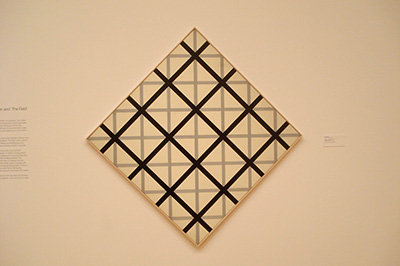
BRISBANE INTERNATIONAL
27 November 2010, 2—6pm
Pestorius Sweeney House, Brisbane
The discourse around art plays an important role in the work of Heimo Zobernig. Accordingly, on the occasion of his 2010 exhibition at the Pestorius Sweeney House, a symposium entitled 'Brisbane International' will be held with the following persons delivering short presentations that reflect upon Brisbane's relation to international developments and tendencies in art and architecture:—
James Birrell is an architect perhaps best known for having designed Brisbane's futuristic Centenary Pools (1957-1959). In 2005 he was awarded the Royal Australian Institute of Architects Gold Medal. Birrell will discuss the brick tradition in post-war Brisbane.
Rex Butler teaches art history at The University of Queensland and is the author of several books on contemporary art and theory. Butler will discuss the Post-Minimal painting of Joseph Marioni, Michael Fried's 1998 analysis of it in Artforum, and the painter's exhibition at the UQ Art Museum in 2000.
A.D.S. Donaldson is a Sydney artist who teaches at the National Art School. Since the late 1980s he has regularly exhibited in Brisbane, while in 2002 the UQ Art Museum hosted the first survey of his work. Donaldson will discuss the English artist Godfrey Rivers' 'At Home' events in Brisbane during the 1890s.
David Pestorius founded his Brisbane gallery in 1993 and in 1999 was the first foreign gallerist to open a showroom in Berlin-Mitte after the fall of the Berlin Wall. He will discuss the origins and evolution of Heimo Zobernig's diamond grid paintings, an ongoing series commenced shortly after seeing Ian Burn's 'Grey Constant' (1966) at the Queensland Art Gallery in 2004.
Jenny Watson is a Brisbane artist. Since the 1980s Watson has regularly exhibited internationally, including with the important Annina Nosei Gallery in New York since 1990. In an echo of the highly personal narratives of her work, Watson will offer a rare glimpse of how she maintains an international practice from a base in Brisbane.
Andrew Wilson is an architect who teaches at The University of Queensland. In 1993 he co-founded the NMBW Architecture Studio in Melbourne. He has also curated significant exhibitions on the pioneers of modern architecture in Brisbane. Wilson will discuss the translation of internationally sourced architectural ideas into the local context.
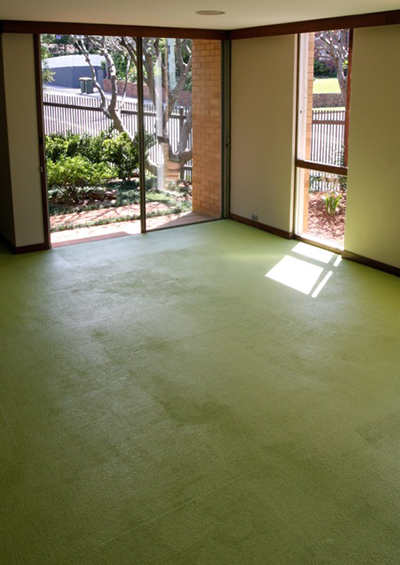
HEIMO ZOBERNIG
17 November—24 December 2010
Pestorius Sweeney House, Brisbane
The Pestorius Sweeney House was designed by Brisbane architect Geoffrey Pestorius (1930–1968) in 1965 for his brother-in-law Robert Sweeney. The two-level brick construction is a fine example of post-war domestic architecture in the International style, its blocky form a synthesis of influences: from Mies van der Rohe’s courtyard house teachings at the Bauhaus to the Californian modernism of Neutra and Eames, traditional Japanese house and garden design, and local architectural ideals and precedents. Over the years, however, the house has been the subject of insensitive alteration, including the removal of extensive mondo grass plantings and its replacement with sandstone paving. The effect was to upset the fluid transition from the olive green carpet of the glazed living/dining room through to the garden and beyond. In the process, the blurring of inside and outside, of private and public, and the sense of transparency and openness so reflective of the architecture’s debt to modernist ideals of the public sphere, were destroyed.
In 1999 restoration of the original design commenced under the supervision of NMBW (Queensland Office). Initially this involved reinstating the courtyard layout and outdoor furniture details. Then in 2002 the artist Catherine Brown began to re-establish the natural contours of the land and the original planting plan of pioneering Brisbane landscape architect Arne Fink. This not only clarified the important spatial role of the stone wall on the Crescent Road boundary, but also revealed a balance of Indigenous and Asia-Pacific species, with the strong presence of Frangipanis, their outstretched limbs greeting the sun and recalling Mies' use of figurative sculpture as a counterpoint to the rectilinear geometry of his Barcelona Pavilion (1929). More recently, the architectural model-maker Peter Morgan has painstakingly reconstructed the distinctive timber slatted fence, which had weathered badly. Concurrent with this program of restoration, the house has been the site for numerous art projects, exhibitions and events.
One of the first artists to offer a work to the house was Heimo Zobernig. In 1999 Zobernig proposed that the olive green carpet be painted a similar green concurrently with the replanting of the mondo grass. It is an inversion typical of the artist's work, what the German thinker Juliane Rebentisch calls its dynamic of permanent reversal. In the decade since offering this work, Zobernig has executed several other artistic interventions at the house: temporary installations that have playfully engaged with the architecture of R.M. Schindler and the Minimal-Conceptual work of Ian Burn. It is only now, however, with the last of the original mondo grass areas recently replanted, that the artist’s floor-piece can be realised, with the work to remain in-situ for an indefinite period.
Heimo Zobernig was born in Mauthen (Carinthia) in 1958. His work has been included in numerous international exhibitions, including Documenta 9 (1992), Documenta 10 (1997), and Documenta 11 (2002). Over the last decade he has had solo exhibitions at major institutions including the Kunsthalle Basel, CAPC Bordeaux, K21 Düsseldorf, Tate St Ives, and MUMOK Vienna, while in 2010 he was awarded the prestigious Kiesler Prize for outstanding achievement in the sphere of architecture and the arts. Zobernig lives in Vienna, where he is professor of sculpture at the Academy of Fine Arts.
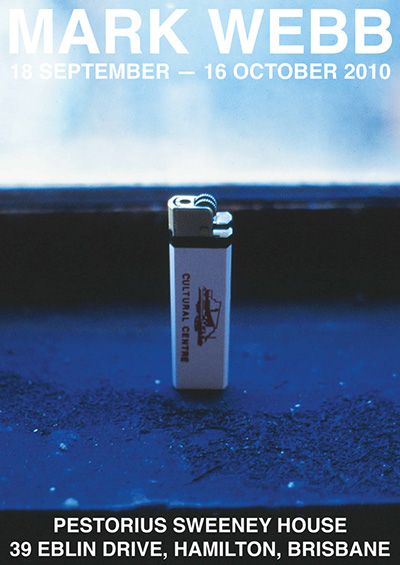
MARK WEBB
18 September—16 October 2010
Pestorius Sweeney House, Brisbane
David Pestorius is pleased to announce the first one-person exhibition in a decade by the Brisbane artist Mark Webb (b. 1957).
In the late 1980s Webb’s paintings had a strong presence in the annual Moët & Chandon national touring exhibitions. Embodying the postmodern idea that “history is a fiction that is in constant flux and continuous becoming” (Webb), the artist’s deployment of found images soon became a critique of the very gesture of appropriation. As the art critic Rex Butler observed in 1991, Webb was “suggesting that, instead of that radical productivity apparently unleashed by this montage of unrelated fragments, this rhetoric has itself become commonplace, banal, conventional.” Perhaps not surprisingly, the artist would soon leave this kind of painting behind and concentrate on other presentational forms and approaches.
In the fickle and highly institutionalised world of contemporary art, Webb’s apparent disavowal of painting was not seen as a good move. That his practice had always embraced more conceptual aspects — the artist’s telegram collaborations with Scott Redford in the '80s are legendary — was overlooked and interest in his work declined. Not one to let these ups and downs trouble him, Webb carried on regardless and today is an extremely respected figure, what we might call an artist’s artist. This is, in part, due to the many years he has spent as a teacher, mostly at the Queensland University of Technology, and Webb readily acknowledges the exchange of ideas with former students, including Peter Alwast, Gordon Bennett, Archie Moore, Sandra Selig, Grant Stevens, and Jemima Wyman. What Godfrey Rivers was to the foundational generation of Queensland Art, Webb has been to the post Bjelke-Petersen generation.
Webb’s exhibition at the Pestorius Sweeney House is something of a historical survey, but one profoundly at odds with the hackneyed conventions of most institutional retrospectives. The show nevertheless brings together a diverse group of works using an array of presentational strategies, which critically facilitate a dialogue across the material and conceptual aspects of the artist’s practice over 25 years. In the result, Webb’s ongoing explorations into art as a model for research, as a site for intermediary exchange between different discursive forms and as a space to engage the politics of the everyday, emerge strongly and clearly.
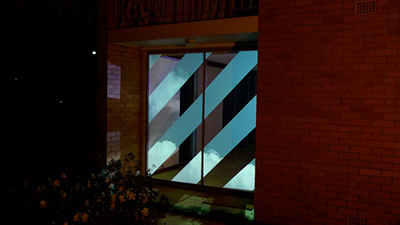
PAUL BAI
31 July—28 August 2010
Pestorius Sweeney House, Brisbane
David Pestorius is pleased to announce a new exhibition by Brisbane artist Paul Bai. It is Bai’s fifth one-person show at the Pestorius Sweeney House since 2001 and will focus on the artist’s video production.
The centrepiece of the show is a new work conceived especially for the house: a looping video of a partly cloudy sky projected onto the abundant glazing of the exhibition space with diagonal strips left clear so the viewer can see through. Only visible at night to passers-by in the street, projected space and real space co-exist in a work that playfully engages the blurring of inside and outside, perhaps the quintessential feature of the architecture.
The exhibition also includes two other recent video works incorporating table and shelf-like elements. Like the space-related work, they reflect Bai’s interest in spatial opposites and extremes. Often involving a sly humour, these ostensibly simple works have the capacity to activate complex meditations on questions of private and public, site and non-site, here and there, present and future, reality and illusion, art and life. They are themes evident in Bai’s earliest videos, which were first exhibited at the 2003 edition of the Art Forum Berlin and are again presented here. A group of four vignettes, they are, in fact, typical of Bai’s work generally in its tendency to confound expectation and first appearances.
Paul Bai was born in Tianjin, China in 1968. He migrated to Australia in 1988 and graduated from the Queensland College of Art in 1995. Since 1996 Bai has had several one-person exhibitions in Australia and internationally, including at Brisbane’s Institute of Modern Art in 2002 and at the Ausstellungsraum Ursula Werz, Tübingen in 2004 and 2006. Over the years, the artist's work has also been presented in group shows, including 1+1+1 at Yuill/Crowley (2004), TURRBAL-JAGERA at the UQ Art Museum (2006), and Primary Views at the Monash University Museum of Art (2008).
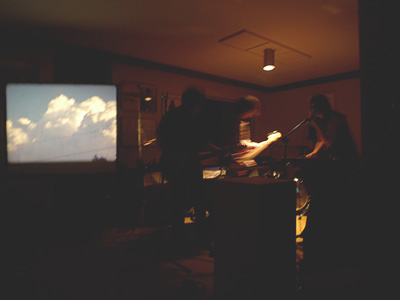
PUNK SUPER 8 IN BRISBANE: Jeanelle Hurst, John Nixon, Gary Warner
7 May 2010, 6–8pm
The Ian Potter Museum of Art, Melbourne*
"What interests a Dadaist is the way he himself lives..." (Tristan Tzara, Dada Manifesto, 1920)
Mirroring street style and contemporaneous popular music, a distinct art practice emerged in Brisbane in the punk/post-punk 'moment' of the early 1980s. Aware of, and informed by, international currents in post-structuralist thought and No-Wave music, radical Brisbane artists nonetheless critically restructured these developments to their own creative ends. Through hybrid, performance-based events involving music, film, installation and performance, the artists in this film program challenged the revered art object as the fetishistic depository of beauty, and, like the Dadaists their work has been compared to, celebrated the power and pleasure of the instantaneous moment. Made in an era of repressive conservative rule and general cultural stagnancy, these Brisbane punk films provide a fascinating glimpse into the experiences of the artists who made them: Gary Warner, John Nixon, and Jeanelle Hurst. Projected from the original Super 8 and preceded by a short discussion by Danni Zuvela/OtherFilm.
* An event of the exhibition MELBOURNE >< BRISBANE:punk, art and after
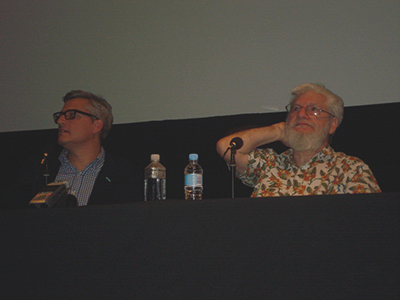
DAN GRAHAM: Rock My Religion
29 April 2010, 6–8pm
Gallery of Modern Art, Brisbane
1 May 2010, 6–8pm
The Ian Potter Museum of Art, Melbourne*
Screening + Dan Graham in conversation with David Pestorius
Influential New York-based artist Dan Graham (*1942) presents a screening of his 55-minute video Rock my Religion (1982–1984), followed by a discussion with Brisbane curator/gallerist David Pestorius.
Rock my Religion reflects on the theory of rock music, and was realised in close collaboration with Thurston Moore and Kim Gordon of avant-garde rock group Sonic Youth and artist Tony Oursler. The film traces the early development of the ‘mosh-pit’ in American music, making links with the ritualistic dances of the Shaker religion founded by Mother Ann Lee in the 1700s.
Rock my Religion is a provocative thesis on the relationship between religion and rock music in contemporary culture. Graham formulates a history that begins with the Shakers, an early religious community who practiced self-denial and ecstatic trance dances. With the 'reeling and rocking' of religious revivals as his point of departure, Graham analyses the emergence of rock music as religion with the teenage consumer in the isolated suburban milieu of the 1950s, locating rock's sexual and ideological context in post-World War Two America. The music and philosophies of Patti Smith — who made explicit the trope that rock is religion — are his focus. This complex collage of text, film footage and performance forms a compelling theoretical essay on the ideological codes and historical contexts that inform the cultural phenomenon of rock'n'roll music.
* An event of the exhibition MELBOURNE >< BRISBANE:punk, art and after
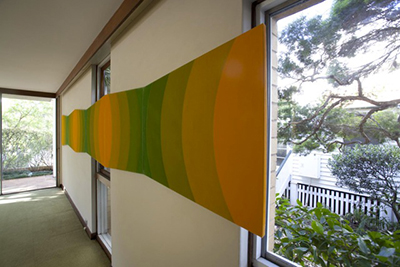
NORMANA WIGHT: Minimal Painting
10 April—8 May 2010
Pestorius Sweeney House, Brisbane
The Field has seminal status in the history of Australian art. It was the first exhibition to be held in the new Roy Grounds’ designed National Gallery of Victoria, and was the first time a major art museum in Australia hosted a large national survey of contemporary art. Opening in August 1968, this groundbreaking show, which featured the latest developments in abstract art, included the work of 40 mostly young artists (the average age was 30).
The Field included a diverse range of abstract tendencies, from Post-painterly abstraction to Pop and Minimal-Conceptual work, although the dominant critical paradigm, as reflected by the catalogue essays, was the formalist rhetoric of New York critic Clement Greenberg. Espousing an approach that underscored the flatness of the canvas and shape of the support, Greenberg and his followers promoted an optical art that sought to overcome illusion and reference, and, above all, shunned duration. For them, “presentness” was grace, whereas the active experience of time was more properly the domain of theatre, and not art.
The Brisbane artist Normana Wight (b. 1936), was one of only three women included in The Field. Both embracing and defying the Greenbergian line, Wight’s severely vertical shaped canvas was amongst the most theatrical works in the exhibition: it demanded that the viewer take action, either through tilting their head or self-consciously adjusting their vision, up and down, in order to take it all in. At the same time, the shape and composition of the painting was the embodiment of the formalist critics' idea of deductive structure. Yet for all this, Wight has been consistently overlooked in the institutional reappraisals of The Field, including such important exhibitions as The Field Now (MoMA at Heide, Melbourne, 1984), and Fieldworks (NGV, Melbourne, 2004).
This small exhibition is designed to begin the process of overcoming this art historical blight, and to reassert the importance of Wight’s early minimalist achievement. Comprising a single multi-panel canvas, which was originally shown at Melbourne’s Crossley Gallery in 1970, its shape and composition of vibrating colour bands recall Wight’s painting from The Field. However, rather than being vertical, the orientation of Wight’s painting is emphatically horizontal, while its flat screen-printed surface also reflects the Minimalist withdrawal traditional painterly subjectivity and embrace of mechanical procedures. It also points to Wight’s move into print making, the field in which the artist is today best known, both as a practitioner and as a teacher.
Exhibition realised in co-operation with Grahame Galleries.
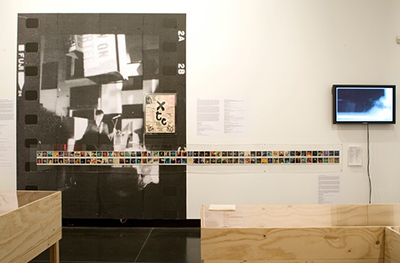
MELBOURNE >< BRISBANE: punk, art and after
24 February—15 May 2010
The Ian Potter Museum of Art, Melbourne
Melbourne >< Brisbane: punk, art and after will trace the extraordinary interaction of the alternative music and art scenes between Melbourne and Brisbane during the punk and post-punk years, 1975–85. The exhibition reveals the entwined artistic and musical histories of the two cities through music, film, ephemeral publications, photographs and paintings by artists including Howard Arkley, Tony Clark, Brett Colquhoun, Peter Cripps, John Nixon, Peter Tyndall and Jenny Watson, and bands such as Anti-music, the Saints, the Go-Betweens, Nick Cave, the Birthday Party, Ed Kuepper, and the Laughing Clowns.
Guest curator David Pestorius, a Brisbane-based arts activist, says Melbourne >< Brisbane explores the development of artists’ practice as a social and strategic experience. “The exhibition highlights a period when the repressive political regime at the time in Queensland drove the Brisbane avant-garde to a musically hungry Melbourne scene, with results that were often creatively explosive,” he says. And Melbourne artists happily took up the challenge to confront the prevailing Brisbane sensitivities. Crossing boundaries between art and music, gallery and gig, the exhibition reveals important strategies in the formation of a postmodern avant-garde, joining clusters of artists united by location, friendship, shared experience and interests. In Australia, punk music offered artists new strategies for collaboration (with artists forming as bands), new models for presentation (promoting and staging exhibitions as gigs), new channels of communication (the cassette, the record, the ‘zine). Above all, punk musicians established new definitions of independent practice. The do-it-yourself mentality that drove punk music was transferred to the art scene, propelling the independent art spaces and magazines that were the foundation of vanguard practices in the 1980s.
Director of the Potter Museum, Dr Chris McAuliffe, says Melbourne >< Brisbane is an opportunity to declare the historical significance of art and punk music in Australia in the late 1970s and early 1980s. “The exhibition will connect audiences with contemporary art through issues and ideas strongly connected with everyday life and popular music,” Dr McAuliffe says. “We retrace a time when Australian punk music led the genre (pre-Sex Pistols) and the creative vibe between Melbourne and Brisbane echoed the Paris/Moscow artistic frisson celebrated in the famous Beaubourg exhibition in Paris in 1979.”
Melbourne >< Brisbane traverses painting, photography, installation, video, film, music and writing. It features rarely seen archival and documentary material, including extensive private archives of audio tapes documenting performances by artists’ bands; Howard Arkley’s personal photographs of his Melbourne ‘Art tram’ and Brisbane ‘Muzak mural’ projects (Brisbane, 1981); Tony Clark’s early DIY operas under the Anti-Music banner; and Brett Colquhoun’s personal dialogue with the late Grant McLennan.
Melbourne >< Brisbane also looks at a number of artist-driven projects that have called attention to this history, not only through its critical re-telling, but also via collaborations which demonstrate that the associations forged during the ‘historical period’ continue to resonate strongly into the present. Beginning with an important series of exhibitions organised by Peter Cripps at Brisbane’s IMA in 1985-86, Melbourne >< Brisbane will also highlight more recent art/music projects involving Tony Clark, Robert Forster, and Ed Kuepper.
As part of the exhibition, New York artist Dan Graham will present a public screening of his film, Rock My Religion, an exploration of threads linking non-conformist religion, counterculture and punk rock.
(Media Release issued by The Ian Potter Museum of Art)
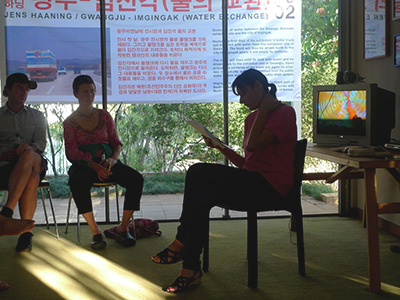
QUEENSLAND ART 2009
5 December 2009—20 February 2010
Pestorius Sweeney House, Brisbane
Fifty years ago, at the behest of the Queensland Art Gallery, Vida Lahey wrote Art in Queensland 1859–1959 (The Jacaranda Press, 1959). As much an activist for art as an artist, Lahey’s groundbreaking history was inclusive. She began with the art of the aborigines and then identified the London-born but Sydney-based painter Conrad Martens as our first non-Indigenous artist. Martens, born and living elsewhere, nonetheless, made an important contribution to art in Queensland and his example prompted Lahey to outline three categories of Queensland artists: firstly, those who have “made their names in the larger art centres and have produced practically none of their work in this State”; secondly, those who have “kept in touch through their work being exhibited here"; and, finally, those who have “produced all their work in Queensland”.
In advance, Vida Lahey contested an approach what would soon dominate the writing of art history in Australia. At the same time as Lahey's book was published in Brisbane, Bernard Smith in Melbourne launched his Antipodean Manifesto. Three years later he published his own history, Australian Painting 1788–1962, and together in these documents Smith enshrined a generation of mostly Melbourne men. In Smith’s masculinist account, Australian art was made by Australians in Australia. In taking this view he turned a blind eye to the work of our expatriate artists, immigrant artists and women artists. This unhappy bias, which excludes much that could assist us in understanding the experience of our artists in the twentieth century, continues today. Not just in the official histories, but also in the nationalism of our survey exhibitions, a construct that still preoccupies many of our State galleries. In a twist, Melbourne parochialism regularly mislabels survey exhibitions of local artists as 'National'.
On the occasion of the 50th anniversary of Art in Queensland 1859–1959, QUEENSLAND ART 2009 takes up Lahey's text and attempts to rethink art in Queensland since 1959. Of course, artists have always lived, studied and worked in Queensland. But equally, they have always left Queensland and worked elsewhere and, as a kind of counter force, they have always come to Queensland to live and to work. QUEENSLAND ART 2009 is structured using these frames, a way of looking at ourselves handed down to us by Lahey, and thus this exhibition is divided into three parts: Art in Queensland, Art from Queensland, and Art of Queensland.
Finally, despite the inclusion of work by a large number of artists, QUEENSLAND ART 2009 makes no claim to being comprehensive. It is clearly subjective in its approach and is therefore, contra Lahey, exclusive. But then, as we know, Brisbane-centrism can generate numerous stories of art in Queensland, and exclusivity is in the nature of every exhibition, even those whose view is wide. And while QUEENSLAND ART 2009 is indebted to Lahey, it also acknowledges the Malcolm Enright and Nancy Underhill curated exhibition Queensland Works 1950–1985 (UQ Art Museum, 1985), its predecessor in the memorialisation of Art in Queensland 1859–1959. Unlike that exhibition, however, QUEENSLAND ART 2009 is not so much concerned to update Lahey, but to recover the polemic found there. It is what we might think of as Lahey's way of thinking ourselves.
Exhibition co-curated with A.D.S. Donaldson.
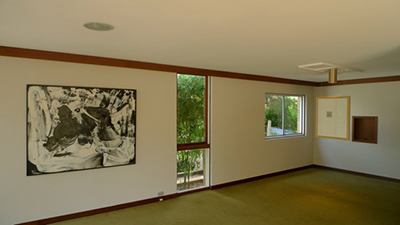
RALPH BALSON: The Black Paintings, 1960–63
12 September—31 October, 2009
Pestorius Sweeney House, Brisbane
Ralph Balson was 70 years old and living in Europe when he commenced the works Daniel Thomas would later call the Black Paintings. Perhaps the least understood Balson series, they were painted between 1960 and 1963, and can appear at odds with his work up to that time. As opposed to his better-known, slowly built up and brightly coloured compositions, Balson’s Black Paintings are poured, trailed and dripped with liquid pigments; they embrace chance effects, but they also reveal highly idiosyncratic brushwork, all within a limited colour range.
In restricting himself to black and white, Balson was pursuing a particular tradition in abstract painting, one closely associated in America with the work of Jackson Pollock and Franz Kline, and in Europe with the work of Hans Hartung and Pierre Soulages, the latter two part of French Painting Today, which had toured Australia in 1953. Balson pioneered this ‘existential’ palette in Australia although he was soon joined by, for example, Tony Tuckson, Peter Upward and later Robert MacPherson. Of course, unknown to Balson, Stacha Halpern had also been pursuing a monochromatic black and white painting in Paris in the late 1950s.
It is hard to understand why Balson’s Black Paintings should be so little known. Certainly they are an identifiable sub-group of the artist’s so-called Matter Paintings, a phase of the artist’s late career that has tended to be regarded as a “bi-way” in his art. This was, for instance, initially the view of Daniel Thomas in his seminal introduction to, and overview of Balson’s work, published in Art & Australia in 1965, and, more or less, it is still the institutional view of Balson today. It is a disposition, however, which not only turns a shoulder to the works pioneering status within the extended field of painting in Australia, but it ignores even Thomas’s substantially revised opinion of the Black Paintings. As long ago as 1969 he declared them to be “the grandest, most museum-worthy, most aristocratic pictures ever made in Australia” and the 40th anniversary of this noble and remarkable correction has provided the spark for this exhibition.
The Sydney artist A.D.S. Donaldson has contributed exhibition design to the show, which focuses on two moments: the Black Paintings initial revelation at the Galerie Raymond Creuze in Paris in late 1960, and the reappearance of the brush in Balson’s painting in 1963, not long before the artist’s death.
Exhibition organised in co-operation with Charles Nodrum Gallery.
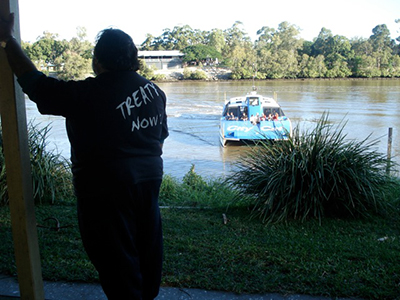
DAVE HULLFISH BAILEY: CityCat Project 2009
Pestorius Sweeney House
Exhibition (9 May—20 June)
CityCat ferries, Brisbane River
Performance with Sam Watson (9 May, 10am–4pm)
State Library of Queensland
Presentation with Sam Watson (10 May, 3—5pm)
Los Angeles artist Dave Hullfish Bailey returns to Brisbane next week to continue work on his collaborative CityCat Project with local Indigenous leader, playwright and activist Sam Watson. Bailey has said “if there's a one-liner about what my [site-based projects] attempt, it has to do with replacing an iconographic vision of place with an inhabited, on-the-ground geography". The artist’s CityCat Project enables us to think this ambition, and the complex space of art it proposes: an unfolding ecology of relations between producers and audiences, histories and locations, aesthetic decisions and political effects.
Commenced in 2003 with a brief to develop a public project for The University of Queensland Art Museum, Bailey's response led him to invite Watson to site, choreograph and theatricalise unannounced interruptions to the routine routing of Brisbane’s popular CityCat ferries. Watson's elaboration of Bailey's proposal not only involved the momentary translation of passing 'scenery' into lived 'place', but constituted a silent yet powerful assertion of Aboriginal culture and history, land-rights and self-determination. So much so, that at a public forum on 3 December 2006, Watson declared the event to be a Dreaming story that local Aboriginal people would tell, re-tell and, hopefully, re-stage into the future. This remarkable development, which is believed to be unprecedented in the history of contemporary art in Australia, further underscores the elasticity of traditional Aboriginal culture and the preparedness of elders to evolve it in dialogue with western aesthetic sensibilities.
While the river performance is at its core, the CityCat Project has activated and continues to activate multiple forms, contexts, producers and audiences, and includes drawings, photographic works, field recordings, exhibitions, architectural interventions, public discussions, printed works and publications. It is this multiplicity of sites and its radically collaborative yet authorially fractured process, which substantially function outside the branded space of art and in dialogue with traditional Aboriginal culture, that marks the CityCat Project as emblematic of advanced art today: an art that reorganises its own relationship to its audience and to its authors.
On Saturday 9 May between 10am–4pm the river performance will be further elaborated by Watson for the first time since he declared it a Dreaming story. Parallel to the river performance, an exhibition by Bailey will open at the Pestorius Sweeney House. The exhibition will include a multi-part photo work first shown as part of the artist's critically acclaimed installation at the Lyon Biennial in 2007. And, finally, on Sunday 10 May between 3–5pm Bailey and Watson will reflect upon the procedures and implications of the CityCat Project in a joint presentation hosted by the State Library of Queensland.
Since 2006 Dave Hullfish Bailey has undertaken major projects for the Secession (Vienna), Centre d'Art Santa Monica (Barcelona), and CASCO Office for Art, Design and Theory (Utrecht). In 2007 a selection of Bailey's projects, including his CityCat Project, was presented at the Lyon Biennial, while in 2009 CASCO and the Sternberg Press will publish the artist’s book What’s Left, with contextual essays by Jan Tumlir, Lars Bang Larson and Emily Pethick.
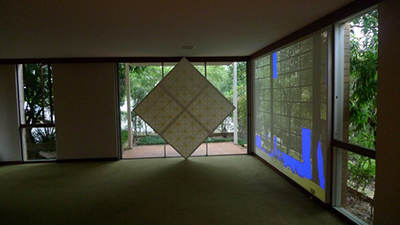
HEIMO ZOBERNIG
27 February—7 March, 2009
Pestorius Sweeney House, Brisbane
Over coming weekends the Austrian artist Heimo Zobernig (*1958) will present a special day/night exhibition, with the gallery open until midnight.
Recently described by the Tate Museum as “one of the most significant artists working in Europe today,” Zobernig’s 25 year survey at Tate St Ives in 2008 was centred around his ‘updating’ of Piet Mondrian’s Composition with Grid 3: Lozenge Composition (1918), a project initiated in 1965 by the Australian artist Ian Burn (1939–1993). An almost perfect modular grid in diamond format, the Mondrian painting anticipated the minimalist injunction to activate and render reflexive the subjectivity of the viewer. However, where Mondrian stopped just short of this ambition, Burn’s Yellow Constant (1965) and related works discarded the last vestiges of a fixed and contemplative viewing position, not only prompting the spectator to become ambulatory, but enlivening the space of the room itself.
In 2004 Zobernig took up from where Ian Burn left off, deliberately undercutting the earnest academicism of Burn’s hard-edge painting with a handcraftedness that fluctuates between the subtle and the slightly absurd. In the end though, the same fundamental questions are being asked: When is a painting finished, who finishes it, and how is the paradigm shift from artist to viewer to be critically analysed and understood? In addition to the materially diverse experiments of these works, Zobernig has often adopted an unconventional approach to their display, something which further emphasises their minimalist polemic. The artist also regularly makes ‘slapstick’ performance/videos that echo and complexify the questions these paintings seem to raise. Over the last decade, many of these videos have deployed the technical trickery of chroma-key production, but in a fairly crude 'low-fi' way, reminding us of the artifice involved and thereby questioning the use of such techniques and materials as a metaphor for the viewer’s own projection.
Confounding traditional notions of exhibition and performance, for this unusual show Zobernig will pair one of his diamond grids from 2006 with his video No. 23 (2005) in a space-related installation that takes its cue from the 8’ ceiling of the venue, an International Style house built in 1965, the same year Burn made Yellow Constant, itself an 8’ lozenge. Zobernig's painting here is also an 8' lozenge — the only work from the series, which now numbers around 20, to adopt the same dimension of the Burn work. But rather than hanging the painting on a wall, the artist will install it more like a sculpture, freestanding in front of and obscuring the view through the abundant glazing of the naturally lit space. The looping video No. 23 will be projected onto the adjacent feature-wall, its moving image only becoming fully legible as night begins to fall.
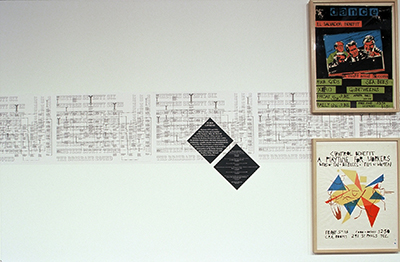
The Brisbane Sound
9 February — 9 March 2008
Institute of Modern Art, Brisbane
Curated by David Pestorius, The Brisbane Sound maps cross-pollination between the alternative music and art scene in Brisbane during the post-punk years, 1978–83. The project concentrates on the role of key individuals, including Ed Kuepper, Robert Forster, and Eugene Carchesio, each of whom curate a concert for the project. In addition to receiving international critical acclaim for their music, Kuepper (founder of The Saints) and Forster (founder of The Go-Betweens) have consistently maintained a working relationship with visual artists and the art world, while Carchesio, who is primarily known as a visual artist, is a product ofthe same music/art milieu.
The Brisbane Sound builds on earlier IMA projects, in particular Ross Harley's groundbreaking 1986 exhibition Know Your Product, which surveyed crossovers between the art and independent music scenes in Brisbane between 1976 and 1986. It was the first time the convergence of local art and music worlds was made visible in an institutional context. Harley's project assembled a breadth of material, arguing that the sorting would come later, and that certain aspects would assume greater significance in thefuture. The Brisbane Sound offers itself as the fulfillment of this idea.
In addition to Kuepper, Forster, and Carchesio, The Brisbane Sound showcases the multifarious activities of Gary Warner — his graphic work, experimental sound works, Super-8 films, and contributions to local indie groups including The Leftovers, Zero/Xero, and Out Of Nowhere — and the graphic work of Peter Loveday, Terry Murphy, and John Willsteed, which paralleled and often served as a critique of Brisbane's dynamic alternative and experimental music/art scenes. The remarkable activities of John Nixon from 1980 to 1981 will also be addressed. Nixon's exhibition program as Director of the IMA and his Anti-Music and Q Space projects challenged institutional orthodoxies and served to collapse the local experimental art and alternative music scenes into one another.
The Brisbane Sound will also include commissioned contributions from Jenny Watson and Andrew Wilson, a rarely seen 1979 television commercial for the Toowong Music Centre featuring The Go-Betweens' Robert Forster and Grant McLennan, and the McLennan-scripted short film Heather's Gloves.
Concert dates: Friday 7 March at 8.30pm: Small World Experience, The Deadnotes, Ian Wadley, Peter Charles Macpherson, Gary Warner (Super-8 films), curated by Eugene Carchesio. Saturday 8 March at 8.30pm: The Apartments, Adults Today, Robert Forster and Adele Pickvance, and Trevor Ludlow and The Hellraisers, curated by Robert Forster. Sunday 9 March at 8.30pm: Ed Kuepper Presents The Ascension Academy.
Artists: Terry Murphy, John Willsteed, Gary Warner, Ian Gray, John Nixon, Jenny Watson, Liam Gillick, Mark Ross, Michael Callaghan, Peter Loveday, Graham Aisthorpe, Judy Dransfield, Robin Gold, Andrew Wilson, Heimo Zobernig, Anne Wallace, and others.
(edited Media Release issued by the Institute of Modern Art)
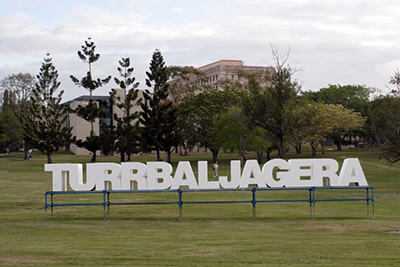
Turrbal-Jagera: The University of Queensland Art Projects 2006
2—17 December 2006
University of Queensland Art Museum, Brisbane
Turrbal-Jagera is a major international open air exhibition designed to engage the public in an exploration of the grounds, precincts and history of The University of Queensland’s St Lucia campus (UQ). Regarded by many as Australia’s most attractive university, it is located a short ferry ride from the city centre on a magnificent 114-hectare site in a bend of the Brisbane River. In addition to expansive landscaped grounds, the campus includes numerous playing fields and important local examples of modern architecture.
In being bounded on three sides by the river, visitors to the exhibition are presented with a relatively contained spatial envelope. Whether on foot or bicycle, the experience appears straightforward enough: with the aid of a pocket map and guide a kind of hide-and-seek game with art is proposed, one that encourages an exploration of both the work and the site together. The encounter is rooted in a process of questioning, one initiated nearly 100 years ago with Marcel Duchamp's ‘readymade,’ an invention that forever changed — and continues to change — the way we think about art. By selecting ordinary mass-produced objects and placing them in an art situation, Duchamp effected a radical shift in the art experience, one that de-emphasised the hand-crafted and retinal in favour of a more conceptual and open-ended approach. Duchamp’s gesture also involved a challenge to the institutional conventions that both make art possible and serve to limit it, so that today the only thing certain is that nothing is certain and fixed.
The legacy of Duchamp’s ‘readymade’ touches almost every aspect of Turrbal-Jagera, from the exhibition’s title acknowledging the local Traditional Owners (the Turrbal and Jagera people), to the nomination of existing locations at UQ as artworks for the purposes of the show. Of course, the early exhibitions of Conceptual Art in the 1960s also often included substantial ‘outdoor’ components and employed titles that sought, like the artworks themselves, to heighten an awareness of time and place. Here, the title not only effects a general awareness of people and place, but also conjures another time and a culture with an ancient dimension.
The concern to bring the past and present into play is also a recurring feature of Turrbal-Jagera. This feature is seen, for example, in the ways that certain existing buildings by James Birrell, Robin Gibson, and Donovan Hill are ‘activated’ as part of the exhibition. Including architecture also squarely raises the question of its status as art, but in addition makes us ask: Is it possible for artists today to work outside art's institutional structures with its network of art museums, galleries, art magazines, etc.? Such issues also concerned early Conceptual Art.
With all of this in mind, it is appropriate that Turrbal-Jagera draw attention to the role of UQ in the realisation of certain important early works of Conceptual Art in Australia. For example, Clive Murray-White’s Smokebomb Sculpture and Tim Johnson’s early performances were both presented at UQ in the early 1970s. These highly abstract and theatrical works confounded the institutional conventions of art, with the role of the viewer challenged as never before. By positioning these now ‘classic’ works within the four walls of the University Art Museum (UAM), and then book-ending them with commissioned works by Heimo Zobernig (Vienna) and Dave Hullfish Bailey (Los Angeles) — each of which also involve substantial 'outdoor' and/or performative components — another layer of reflexivity is added to enliven them critically.
This exhibition is titled Turrbal-Jagera as a gesture of deep respect and cultural sensitivity to the traditional owners and custodians of the country on which The University of Queensland has been built. The included artworks explore themes and tensions that are intended to transcend borders and boundaries, and celebrate the higher elements of universal humanity and our interaction with the natural environment. The fact that we are carrying out this activity on Turrbal/Jagera land is in no way intended to make any assumptions about the cultural practice of the Turrbal and Jagera people, or the way in which they celebrate their place in the natural order of life.
artists/writers: Abject Leader (Brisbane) Paul Bai (Brisbane) Dave Hullfish Bailey (Los Angeles) James Birrell (Brisbane) Peter Bonde (Copenhagen) Stephen Bram (Melbourne) Catherine Brown (Brisbane) Burchill/McCamley (Melbourne) Catherine Chevalier (Paris) Edward Colless (Melbourne) A.D.S. Donaldson (Sydney) Donovan Hill (Brisbane) Andreas Exner (Frankfurt) Matthys Gerber (Sydney) Robin Gibson (Brisbane) Jens Haaning (Copenhagen) Leni Hoffmann (Düsseldorf) Tim Johnson (Sydney) Lost Domain (Brisbane) Nevil Matthews (Brisbane) Gerold Miller (Berlin) Archie Moore (Brisbane) Clive Murry-White (Melbourne) Robert Owen (Melbourne) O’Conner + Houle (Melbourne) Anu Pennanen (Helsinki) Scott Redford (Brisbane) Rebecca Ross (Brisbane) Anne Wallace (Brisbane) Jeffrey Wegener (Sydney) Sam Watson (Brisbane) Chris Wilder (Los Angeles) Heimo Zobernig (Vienna)
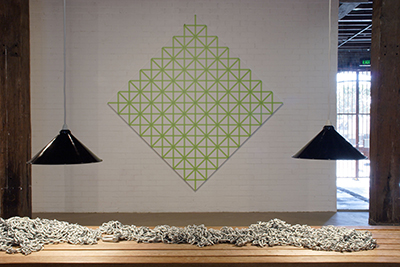
HEIMO ZOBERNIG
6 April—6 May 2006
Artspace, Sydney
The Austrian artist Heimo Zobernig is regarded internationally as one of the most important inheritors of the Conceptual Art legacy. Traversing a broad range of media, Zobernig's work playfully continues the reductivist program of Modernism, in the process exploding its many myths and misconceptions. In recent years Zobernig has closely engaged with the Minimal-Conceptual work of renowned Australian conceptual artist Ian Burn (1939–1995), critically extending Burn's 1965 ‘updating' of Mondrian, rethinking his use of mirror, and, along the way, enlivening debates regarding official accounts of Art & Language history.
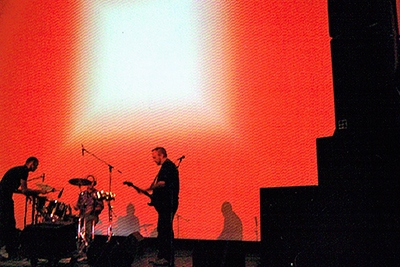
Ed Kuepper's MFLL
26 January 2003—17 July 2005
Pestorius Sweeney House, Brisbane; Artspace, Sydney; Australian Centre for the Moving Image, Melbourne; Sydney Opera House; Institute of Modern Art, Brisbane; Fondation Cartier pour l'art contemporain, Paris; Volksbühne, Berlin; Burgtheater, Vienna; Filmmuseum, Vienna; Musterraum, Pinakothek der Moderne, Munich; Le Printemps de Septembre, Toulouse; Perth International Arts Festival; Queensland Music Festival, Brisbane Powerhouse
One of the ‘godfathers’ of punk music Ed Kuepper, together with musical collaborator Jeffrey Wegener, embark on a special adventure with an international cast of artists. Their mission: the raw physical interface between sonically explosive live-music and large-scale video projections. Inspired by the experimental films of Len Lye (1901–1980) and embracing advanced as well as ‘primitive’ technologies and processes, sound and image merge in amazing synchronicities and to powerful effect. And while music and the moving image mingle and mix, there is also no clear sense of them being ‘illustrative’ of one another, as one tends to find with pop videos. Rather, the result is a highly suggestive and independent reality, the ‘now’ perhaps only possible in a live concert-like situation.
This project was initiated in 2002 when Ed Kuepper was commissioned to create new live scores for several short films by Len Lye. After presenting this project in Brisbane, Sydney and Melbourne, an international grouping of contemporary artists was commissioned to make new video films to accompany the music that Kuepper had created for the Lye films.
Collaborating artists: Heimo Zobernig (Vienna) Chris Wilder + Richard Louderback (Los Angles) Gerold Miller (Berlin) Leni Hoffmann (Düsseldorf) Jens Haaning + Chung Haessen (Copenhagen) Dominique Gonzalez-Foerster (Paris) Liam Gillick (New York) A.D.S. Donaldson (Sydney) Tony Clark + Melita Dahl (London) Eugene Carchesio (Brisbane) Burchill/McCamley (Melbourne)
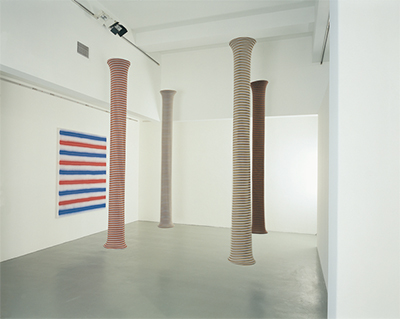
A.D.S. DONALDSON
4 May—15 June 2002
University of Queensland Art Museum, Brisbane
This mid-career survey traced 15 years of work by A.D.S. Donaldson (*1961), the Sydney artist well-known for his interest in the contemporary possibilities for abstraction. Whether it be geometric or gestural, the product of hand-made or industrial processes, Donaldson's practice is highly conscious of the fact that it emerged after Conceptual Art appeared to shut the gate on the grand ambitions of the Modernist project. For Donaldson, like many others, rather than being a limitation, the lessons of Conceptual Art proved liberating and pointed the way to an art that might explore the ordinary, the overlooked, the mundane and the everyday. Conceptual Art was about challenging expectation and convention and we see this challenge everywhere in his work. For Donaldson, there is no right or wrong way to do or to make things. There is only another way and if this appears not to follow the rules then this is no accident. Perhaps the most significant and relatively recent development in Donaldson's work is its embrace of so-called 'Aboriginal Abstraction', not so much its traditional/spiritual roots in the songlines of the Dreaming, but in its formal and technical methods. Untrained in our conformist art schools, Indigenous artists, according to Donaldson, challenge their white contemporaries and their work speaks to our common future.
The exhibition was accompanied by a fully illustrated catalogue, with an introduction by David Pestorius and commissioned essays by Carolyn Barnes (Swinburne University) and Toni Ross (CoFA, UNSW), photo-documentation of past exhibitions, numerous installation views and details of the works included in the survey, an informative biography and exhibition history, and a comprehensive bibliography. The artist also produced an A0 format poster for the project.
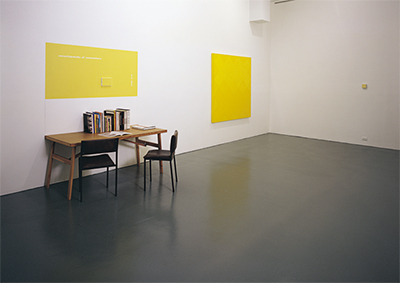
MONOCHROMES
7 December 2000—24 February 2001
University of Queensland Art Museum, Brisbane
Monochromes was the first major survey in Australia of artists working with a single colour. It presented artworks produced over the previous 35 years by more than 45 Australian and foreign artists who have exhibited work of this nature in Australia. The approach adopted involved selecting one work by each artist and grouping them by colour. And rather than including only artists who might be considered 'hard-core' exponents of the painted monochrome, a more expanded view of monochromatic practice was embraced, one that acknowledged critical shifts in contemporary practice since the 1960s, with numerous conceptual and post-conceptual works presented.
A substantial catalogue, with an introduction by David Pestorius, commissioned essays by Andrew McNamara (QUT) and Morgan Thomas (UQ), and comprehensive installation view photo-documentation, was produced in the immediate aftermath of the exhibition.
artists: Ian Anüll (Zurich) Peter Bonde (Copenhagen) Peter Booth (Melbourne) Ian Burn (Melbourne) A.D.S. Donaldson (Sydney) Mikala Dwyer (Sydney) Andreas Exner (Frankfurt) Dale Frank (Brisbane) Marco Fusinato (Melbourne) Gail Hastings (Sydney) Leni Hoffmann (Düsseldorf) Robert Hunter (Melbourne) Robert Jacks (Melbourne) Gerold Miller (Berlin) Ian Milliss (Sydney) Elizabeth Newman (Melbourne) John Nixon (Sydney) Rose Nolan (Melbourne) Robert Owen (Melbourne) Wendy Paramour (Sydney Ti Parks (Melbourne) Mel Ramsden (Oxfordshire) Robert Rooney (Melbourne) Chris Wilder (Los Angeles) Heimo Zobernig (Vienna), and others.
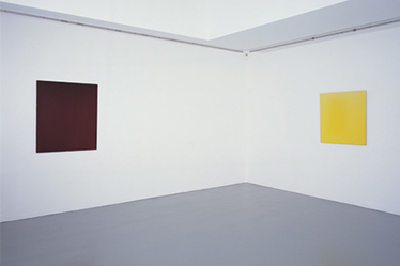
JOSEPH MARIONI
7 December 2000—24 February 2001
University of Queensland Art Museum, Brisbane
This was the first exhibition in Australia by New York painter Joseph Marioni (*1943), and was organised to coincide with the historical survey Monochromes at the same venue. Marioni's paintings defy interpretation for at the heart of his enterprise is colour, that most difficult of subjects to discuss. Nevertheless, in 1998 the art historian Michael Fried was effusive, describing them as "paintings in the fullest and most exalted sense of the word". More recently, in a chapter devoted to Marioni in his book Four Honest Outlaws, Fried went out on a limb expressing the view that Marioni is "the strongest painter of whom I have knowledge at work anywhere today".
The four small and mid-format paintings in this exhibition came at a time of great refinement in Marioni's work. Appearing as if they have 'painted themselves', these sensuous objects capture light within successive veils of liquid paint and depending on the atmospheric conditions (the painter's work is best experienced in natural light) suggest a certain depth within or behind the surface. This is perhaps at its most astonishing in the yellow paintings, where, to quote again from Fried, the colour seems "to rise and not to stop so much as evanesce, become dematerialised, in the upper reaches of the canvas".
A fully illustrated catalogue, with an introduction by David Pestorius and commissioned essay by Rex Butler (UQ), was produced on the occasion of the exhibition, which coincided with the annual conference of the Art Association of Australia and New Zealand, where Marioni was one of the keynote speakers.
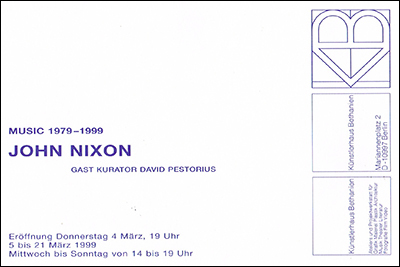
JOHN NIXON: MUSIC 1979-1999
5–21 March 1999
Künstlerhaus Bethanien, Berlin
With the international advent of Punk, artists associated with the Conceptual turn of the 1970s began to see rock 'n' roll as offering new possibilities to keep working in a relevant, critical way. Punk's embrace of amateurism — the liberating possibility of working without being weighed down by conformist academic training — was also an important principle for Conceptual artists, while John Cage's notion of 'all sound is music' was another driving force.
John Nixon (*1949) was a pioneer in this field in Melbourne and Brisbane during the late 1970s and early 1980s, while in the mid 1990s he returned to the well, often working in collaboration with Marco Fusinato. This small exhibition was the first survey of Nixon's music related activities and was accompanied by small catalogue, with an introduction and a lengthy interview with John Nixon by David Pestorius.
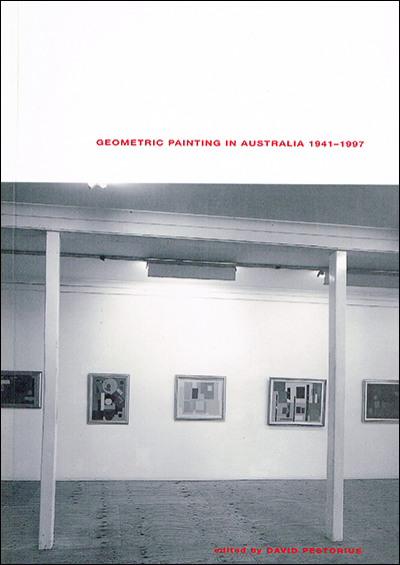
GEOMETRIC PAINTING IN AUSTRALIA 1941-1997
15 August— 17 October 1997
University of Queensland Art Museum, Brisbane
The first major historical survey in Australia of Geometric Abstraction, commencing with Ralph Balson's one-man show at the Anthony Horderns Gallery in Sydney in 1941 and concluding with Melbourne's Store 5 artists of the early 1990s. The exhibition featured the works of over 40 artists and was accompanied by a substantial fully illustrated catalogue, with an introduction by David Pestorius, commissioned essays by Rex Butler (UQ), Chris McAuliffe (Melbourne University), and Carolyn Barnes (Swinburne University), and comprehensive installation view photo-documentation.
artists: Ralph Balson (Sydney) Peter Booth (Melbourne) Stephen Bram (Melbourne) Angela Brennan (Melbourne) Mike Brown (Sydney) Ian Burn (Melbourne) Eugene Carchesio (Brisbane) Grace Crowley (Sydney) A.D.S. Donaldson (Sydney) James Doolin (Melbourne) Lesley Dumbrell (Melbourne) Hector Gilliland (Sydney) Melinda Harper (Melbourne) Frank Hinder (Sydney) Robert Hunter (Melbourne) Robert Jacks (Melbourne) George Johnson (Melbourne) Anne-Marie May (Melbourne) Tony McGillick (Sydney) Elizabeth Newman (Melbourne) John Nixon (Sydney) Rose Nolan (Melbourne) Robert Owen (Melbourne) Ti Parks (Melbourne) Elizabeth Pulie (Sydney) Robert Rooney (Melbourne) Trevor Vickers (Melbourne) Gary Wilson (Melbourne), Constanze Zikos (Melbourne), and others.
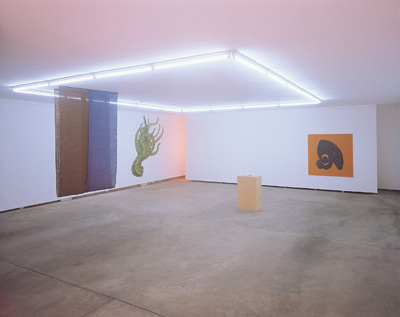
DISCOVERING THE 'FEMININE'?
10 March—1 April 1995
David Pestorius Gallery, Brisbane
The idea for this exhibition initially came from a passage I stumbled across while reading the ACCA catalogue essay for Tony Clark's by now well-known appropriation of Eva Hesse, Important Contemporary Sculpture, 1994. Written by Judith Pascal (one of Clark's female pseudonyms), the passage goes:
"Clark's work might be seen as a doubling of the inversion performed by feminist artists, most notably Sherrie Levine, in her appropriations of works by famous male artists. Is it for Clark a plagiaristic method of discovering the 'feminine'? Or is it a jibe at the reified aura of Hesse?"
As Pascal asks, what is the point Clark is trying to make by means of his appropriation of a female artist? To quote from her essay again: "What are we to make of this appropriation, by a male artist, of a canonical female 'master' piece?" Implicit in her question is the notion that Clark is merely re-establishing the male order of art, reducing the ambiguity and difference of Hess's original to the norms of male spectatorship. Clark's would be a particularly pointed appropriation, too, in that works like Hesse's has recently been adopted by a younger generation of female artists who have found in its characteristic formlessness, use of low or domestic materials and theatrical presentation inspiration for their own practice.
My aim in taking up this passage as the basis for an exhibition is neither to justify Clark's appropriation, nor to repeat Pascal's criticism. Rather, it is to investigate the contradiction of Clark's initial gesture whereby he both appropriates from Hesse's work and then, using a female pseudonym, denounces himself for doing so. I think Clark's work was speculative in the best sense of the word in that he himself was not sure of the ultimate meaning of his actions. Was he merely repeating the classic 'masculinist' strategy of appropriating from women artists? Or was he opening up the possibility of these artists entering the canon of Wester art? Was he a male taking from a female artist or a male artist acknowledging certain 'feminine' tendencies in his own work?
In the end perhaps, Clark's work might allow us to think the limits to classifying art as either exclusively masculine or feminine. Is it true that there is any kind of art that is inherently feminine, for example, either because it has been made by females or because of certain formal properties it might have? Looking at the artists shown here, it can be seen that in many ways their work exhibits a number of 'feminine' qualities. But, again, rather than allowing us to speak of it as feminine, does it not hint at the restrictiveness of these kinds of categories in speaking about art? Are not these artists trying to think beyond the simple division between masculine and feminine, and in what ways might this be itself a 'feminist' project? It might be that, instead of appropriating feminine art, they are giving away their historical privilege as male artists, learning to make and think about art in a different way.
A small offset printed catalogue, with introduction by David Pestorius (text above) and a commissioned text by Rex Butler, was produced on the occasion of this exhibition, which would later tour to the Perc Tucker Regional Gallery in Townsville, and be the subject of substantial critical reception.
artists: Hany Armanious (Sydney) Adam Boyd (Brisbane) Tony Clark (Melbourne) A.D.S. Donaldson (Sydney)
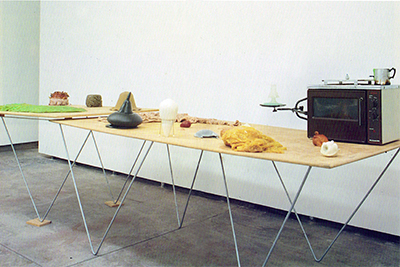
HANY ARMANIOUS
20 May—11 June 1994
David Pestorius Gallery, Brisbane
It is not so well-known that the original manifestation of Selflok by Sydney artist Hany Armanious (*1962) was conceived for and shown at the David Pestorius Gallery, Brisbane in May 1994. The most complex and narrativistic of Armanious' signature 'hotmelt' creations of the 1990s, Selflok is now in the collection of New Zealand's Govett-Brewster Art Gallery, which describes it like this:
"Selflok is an evolving scatter-installation work created from a wunderkammer-like collection of everyday, found objects that lead into a fairy-tale realm with weirdly out-of-scale objects, illustrating a heightened, fantastical perspective of the ‘true nature of realism’. In previous works, the artist introduced hallucinogenic-inspired quest philosophy and shamanism through referencing Carlos Castaneda’s book The Teachings of Don Juan: a Yaqui Way of Knowledge 1968, alongside elements of popular culture. This approach leads to the interpretation of objects within Selflok – pipes, a Central American pyramid, a rabbit and elf hats – that reference transformations from fairytale fantasylands or drug-induced worlds."
While Selflok had evolved quite considerably by the time it was shown to great fanfare at the Hammer Museum in Los Angeles in 2001, for many the original form of the installation and its subterranean context — the original David Pestorius Gallery was located in the basement of a Fortitude Valley warehouse — made for a much more compelling, indeed surreal, experience. Fortunately, a small catalogue, which included a brief essay by Edward Colless, was produced at the time the original work was shown. It was one of several offset-printed A5 format catalogues published by David Pestorius during the 1990s. Although now extremely rare, it does capture something of the original work's magic and mystery.
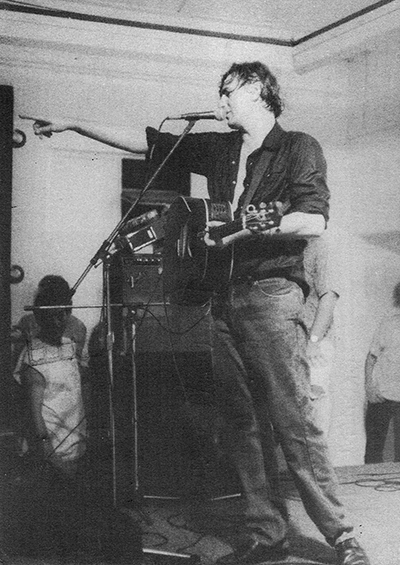
ROBERT FORSTER
29 + 30 January 1993
Institute of Modern Art, Brisbane
In 1992, when Robert Forster (*1957) returned to live in Brisbane following the break-up of The Go-Betweens (1978–1989; 2000–2006), he had not lived in his home-city for over a decade. He had earlier recorded the exquisite solo album Danger in the Past (1990) in Berlin, but decided a return to where it all began was called for with his second album, the equally remarkable Calling from a Country Phone (1993), which was completed with local musicians late in the year. At the same time as Forster was putting the finishing touches on the new album, he began preparations for a series of concerts, which would be his first shows in Australia as a solo artist.
As with everything Forster does, the venue and bill were carefully considered. Rather than launch his solo career at a conventional rock venue, Forster chose the white cube of Brisbane's Institute of Modern Art and approached David Pestorius to organise a line-up that would shine a light on his early years in the city and avant-garde credentials. To that end, John Nixon (*1949) was invited to recuperate his collaborative Anti-Music project, which had released a split-cassette with The Go-Betweens in 1981. This posed the question of how to present what was essentially a non-performative recording project (by visual artists) in a live concert situation. In 1999, Nixon reflected on his approach:
"When invited to be included on the 1993 Robert Forster IMA concert line-up I thought it appropriate to present a random group of 'songs' from the Anti-Music catalogue in the form of a self-contained concert. In a concert you usually demarcate the main acts from the 'recorded music' played between bands — so how could this be done with recorded music as an act? A white banner with the words ANTI-MUSIC was pinned up at the beginning of the Anti-Music section of the concert and the sound volume turned up much louder than the 'background between bands music' had been. The audience began to take an interest and listen. At the end of half and hours worth of various numbers, the sound was turned off and the banner taken down, indicating the finish of this section of the concert."
In addition, the Brisbane artist/musician Eugene Carchesio (*1960) was invited to perform tracks from his recent DNE album. Carchesio's group at the time, the Holy Ghosts, continued a post-Velvet Underground tradition in Brisbane, which began in the late 1970s with The Go-Betweens and became known as 'the Brisbane Sound'.
A small photocopied program, with an introduction by David Pestorius and Anti-Music insert, was produced for the Forster shows, which also featured slide projections by then IMA Director Nicholas Tsoutas. Both shows sold out with around 400 persons in attendance each night.
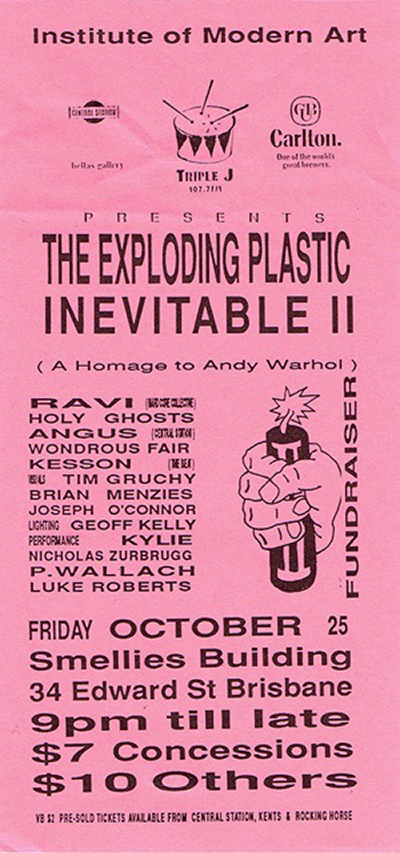
EXPLODING PLASTIC INEVITABLE 11
25 October 1991
Institute of Modern Art, Brisbane
In 1991 the old Smellie & Co warehouse at the Botanical Gardens end of Edward Street in Brisbane was in a poor state of repair and no longer occupied. The State government managed the building and agreed that it might be used for a one-night only event held under the auspices of the Institute of Modern Art, which promoted the show as a fundraiser.
From an artistic perspective, the event was conceived as a kind of contemporary updating of the famous multimedia show that Andy Warhol devised around performances by the Velvet Underground in 1966.
With this in mind, local artists were engaged to create interactive lighting and space-related installations, while key local indie music groups, including Eugene Carchesio's Holy Ghosts — local inheritors of a tradition handed down by the Velvets — performed brief sets. These were interspersed with 'art performances' by local visual artist Luke Roberts, cultural theorist Nicholas Zurbrugg, and actress Peggy Wallach, while a popular local drag queen, whose act was based on that of Kylie Minogue, stole the show. Warhol surely would have approved!
Later in the evening an array of Brisbane's leading DJs performed diverse sets of dance music (Hip hop, Techno, etc) into the early hours of the morning.
